Highlights
What are the main findings?
- Sustainable Retrofitting Techniques: This review paper critically examines various fiber retrofitting and upgrading techniques: (1) mechanical, (2) thermal, and (3) integrated (structural and thermal).
- TRM vs. FRP Systems: Textile reinforced mortar (TRM) systems offer superior performance compared with fiber reinforced polymer (FRP) systems in masonry retrofitting, due to better material compatibility, breathability, fire resistance, and lower environmental impact.
- Integrated Retrofitting: Combining structural and thermal retrofitting techniques, such as in the case of natural fiber TRM (NFTRM), enhances the load-bearing capacity of masonry walls while improving their insulation properties, addressing both seismic resilience and energy efficiency. Notably, standards/guidelines are absent for NFTRM system applications.
- Challenges and Future Research: Further research is needed into fiber treatments, hybrid reinforcement strategies, and the durability and moisture absorption problems.
What are the implications of the main findings?
- Sustainability: The innovative application/use of natural fiber-based building materials can support global sustainability goals. Notably, it can help in reducing dependence on synthetic materials and minimize the carbon footprint.
- Cost-Effectiveness: Integrated (structural and thermal) retrofitting approaches, such as the use of NFTRM, aim to lower long-term maintenance costs and extend the lifespan of buildings.
- Seismic Resilience and Energy Efficiency: Improved structural and thermal performance (separately or via integrated retrofitting approaches) of retrofitted masonry walls addresses vulnerabilities in unreinforced masonry (URM) structures, an essential factor for buildings in earthquake-prone areas and for reducing overall energy consumption.
Abstract
This study presents a comprehensive review of various advanced methodologies that have been used to enhance the structural and thermal performance of masonry walls through innovative and sustainable retrofitting/upgrading techniques. Focusing on three primary approaches—mechanical/structural retrofitting, thermal retrofitting, and integrated (structural and thermal) retrofitting, this paper critically examines various masonry-strengthening strategies. Retrofitting techniques are categorized by material use and objectives. Fiber-based solutions include insulation materials, fiber composite mortar for strength, FRP for high-strength reinforcement, and TRM for durability. According to the relevant objectives, retrofitting can enhance structural stability (FRP, TRM), improve thermal insulation, or combine both for integrated performance. Particular emphasis is placed on the effectiveness of TRM systems, with a comparative analysis of man-made (glass, steel textile) and natural fiber-based TRM solutions. Regarding integrating natural fibers into TRM systems, this study highlights their potential as eco-friendly alternatives that reduce environmental impact while maintaining or improving structural integrity. Furthermore, it highlights and examines techniques for testing masonry walls. In this context, this review highlights the applicability of natural fiber as a sustainable building material in various retrofitting/upgrading solutions.
1. Introduction
For centuries, masonry structures have been an integral part of human civilization. Considering their durability and aesthetic appeal, masonry construction techniques have been used for building houses and various structures. Unreinforced masonry (URM) structures, which constitute a significant portion of historical and residential buildings, are highly vulnerable to seismic events [1]. Therefore, the majority of them urgently need retrofitting or upgrading [1]. In recent years, the majority of the research focus has shifted towards sustainable solutions that improve the structural as well as thermal performance of buildings, simultaneously aligning with environmental, seismic [2], and energy [3] standards.
Fiber-reinforced polymer (FRP) and textile-reinforced mortar (TRM) techniques are commonly utilized for structural strengthening [4], while TRM is more suitable for masonry interventions [5]. Notably, fiber-reinforced polymer (FRP) systems are well known for their strength [6], and they have predominantly been used for seismic retrofitting. FRP installation requires polymeric resins, which have a much higher environmental impact [7] that further compromises their compatibility with masonry structures.
The use of TRM systems for upgrading and retrofitting masonry buildings and structures is becoming increasingly common in the construction and building (CB) sector. TRM systems are well suited for upgrading or retrofitting masonry structures because of their better deformation capacity [8] and high strength-to-weight ratio (this ratio ensures that structures experience minimal added weight while still benefiting from significant tensile strength) [9], therefore enhancing the overall mechanical performance and reducing stress concentration due to higher homogeneity between TRM and masonry [8]. The mechanical performance of TRM has demonstrated satisfactory results following exposure to fire [10]. TRM systems integrate fibers into an inorganic cement matrix, enhancing breathability and compatibility with masonry.
Manmade and mineral textiles or fabrics (steel–TRM [11,12], glass–TRM [13,14] carbon–TRM [15,16,17,18,19], basalt–TRM [20,21,22], and polypropylene–TRM [23]) are mostly used for experimental and commercial TRM retrofitting purposes.
One key strategy in sustainable masonry retrofitting is implementing natural fiber-based reinforcement systems, like natural fiber composite mortar (NFCM) [24,25], natural fiber-reinforced polymers (NFRPs) [26], and natural fiber textile-reinforced mortar (NFTRM) [27]. This approach enhances structural integrity while promoting environmentally friendly practices. Notably, natural fibers have a 78–79.4% smaller carbon footprint than glass and mineral fibers [28]. Therefore, natural fibers can boost sustainability by reducing reliance on synthetic materials [29]. Further, it is essential for the construction and building (CB) industry to utilize sustainable, eco-friendly, and easily decomposable building materials in order to address environmental and ecological issues caused by construction and demolition (CD) waste landfilling [30]. Various innovative recent research in CB applications has explored the use of various natural fibers (animal- and plant-based) such as bamboo fiber [31], sheep wool [32,33], date palm fiber [34], oil palm fly ash fiber [35], sisal fiber [36,37], curauá fabric [38], kenaf fiber [39], alfa plant fiber [40], and hemp fiber [41].
The growing awareness of sustainability and the demand for greener masonry retrofitting and upgrading methods have driven research toward using NFTRM systems, and scientists and researchers are working on incorporating NFTRM systems [27,42,43] into modern construction practices.
The prime objectives of this review are to critically examine a range of fiber retrofitting and upgrading techniques, decisively comparing the advantages of textile-reinforced mortar (TRM) systems with those of fiber-reinforced polymer (FRP) systems. This review highlights the pivotal role of natural fibers in advancing sustainable retrofitting and upgrading practices, showcasing their impressive mechanical and thermal properties. In addition, it provides a thorough analysis of various masonry testing methods and standards that effectively evaluate the success of retrofitting techniques. Moreover, it comprehensively investigates the integration of retrofitting and upgrading strategies for masonry walls using TRM systems, focusing on the superior performance of masonry walls strengthened with both man-made and natural fiber TRM systems. Importantly, this review underscores the significant potential of natural fibers as a sustainable alternative for retrofitting applications.
This paper is structured as follows. Following a brief introduction, Section 2 describes the methodology used to develop this review paper. Section 3 states different fiber retrofitting/upgrading techniques. In Section 4, various masonry testing methods and standards are explained, and in Section 5, examples of masonry wall testing methods are discussed. Section 6 describes masonry wall structure upgrading with a natural fiber TRM system, and testing. In Section 7, integrated TRM retrofitting and upgrading with man-made vs. natural fibers is discussed. Some important research works and respective findings are discussed in Section 8. Concluding remarks are stated in Section 9.
2. Methodology Applied in This Review Paper
The following methodology was applied during the development of this review paper. This paper aims to comprehensively review natural fiber-based reinforcement for mechanical, thermal, and integrated (structural and thermal) systems.
- Considering the research scope and objectives, this study focuses on sustainable retrofitting and upgrading techniques for masonry walls. It provides a systematic review of existing research, experimental studies, and international standards related to masonry retrofitting. Comparative studies on the mechanical and thermal performance of different reinforcement building materials and testing techniques are analyzed.
- Classification of various retrofitting techniques is discussed in this review paper, focusing on (i) mechanical/structural retrofitting, considering tests performed at small or structural scale, (ii) thermal retrofitting to improve energy efficiency with fiber insulation materials, and (iii) integrated (structural and thermal) retrofitting, combining mechanical and thermal enhancements.
- Various experimental TRM-system reinforced masonry wall testing methodologies are also considered, including (i) diagonal tension (shear) tests, (ii) in-plane cyclic tests, and (iii) compressive strength tests.
- A comparative study between man-made and natural fiber-based TRM is also provided at the end of this paper, primarily focusing on analyzing TRM systems using man-made fibers (like glass, carbon, basalt, and steel textiles) and natural fibers (like jute, hemp, flax, etc.).
3. Different Fiber Retrofitting/Upgrading Techniques
Retrofitting/upgrading techniques can be categorized depending on various strengthening objectives, as below:
- (a)
- Use and Application of Fiber and Fiber Products:
- Fiber insulation materials: mainly man-made (glass [44]) or natural fibers (sourced from animals: sheep wool [45,46], and sourced from plants: jute [47], hemp [48], sisal [49], banana [50] etc.), used to produce insulation materials with the aim to be used for enhancing the energy efficacy of buildings.
- Fiber composite mortar: in this case, fibers (such as carbon [51], basalt [52], glass [53], polypropylene [54] or natural fibers [55]) are integrated into the mortar to enhance its mechanical properties, such as strength, ductility, and durability, and/or to improve masonry structures’ thermal performance (particularly in the case of natural fiber composite mortar).
- Fiber-reinforced polymer (FRP) [56]: FRP systems are widely used for retrofitting masonry and concrete structures. Notably, FRP is known to have a high strength-to-weight ratio, providing excellent tensile and compressive strength. Also, FRPs are lightweight and enhance the seismic resistance and load-bearing capacity of structures.
- Textile-reinforced mortar (TRM) [57]: TRM, or fiber-reinforced cementitious matrix (FRCM), uses textiles (often carbon, basalt, or natural fibers like jute) embedded in a cementitious matrix to strengthen masonry and concrete. Unlike FRP, TRM avoids the use of polymers, making it more compatible with the structure’s substrate, especially in terms of breathability and long-term durability.
- (b)
- Based on the Final Objective of Retrofitting/Upgrading:
- Mechanical/structural reinforcement: in this case, the prime objective is to enhance the load-bearing capacity, strength, and stability of a targeted system. FRP [56] and TRM [57] systems can be used for this purpose, as they help improve the structure’s tensile strength and stiffness.
- Thermal reinforcement: as a way to improve the thermal performance of buildings, which helps prevent heat loss or enhances thermal insulation. This is typically achieved through the use of specialized composites and mortars [58], which include thermally insulating materials (e.g., fiber-made insulation panels [44,45]).
- Integrated (thermo-mechanical/thermo-structural) reinforcement [27,59]: a retrofitting/upgrading approach that combines mechanical and thermal improvements. Systems like TRM can offer an integrated solution by enhancing a building’s structural integrity and thermal performance.
3.1. Natural Fiber Reinforcement
Natural fiber reinforcement refers to the incorporation of plant or animal fibers [60] into construction materials, such as cement and polymers. This approach enhances the mechanical properties of these materials and promotes sustainability in construction practices. Natural fibers (Figure 1), including jute, hemp, flax, sisal, and palm, are particularly esteemed for their environmental benefits, renewability, and biodegradability [61]. When natural fibers are integrated into construction materials, it helps in improving properties such as tensile strength, ductility, and resistance to cracking [62,63], while also offering thermal insulation [26] and reducing the overall carbon footprint of building systems.

Figure 1.
Natural fibers and their origin (Reproduced from [60]).
The majority of the research available in the literature highlights either the mechanical performance or thermal behavior of natural fiber building materials, while studies focused on thermal and mechanical performances simultaneously are rare. Figure 2 underlines three main uses and applications of natural fiber as a retrofitting/upgrading material, focusing on three key aspects: mechanical/structural properties, thermal properties, and integrated (structural and thermal) properties. Mechanical/structural properties are primarily considered in relation to enhancing the strength and ductility of the structure; therefore, adding natural fibers (composite materials or fabric form) is suitable for strengthening and load-bearing applications. Research into the thermal properties mainly aims to improve the insulation capacity of materials or structures. Materials with integrated structural and thermal properties are highly valued, as they provide the balanced performance required for modern construction and building applications.
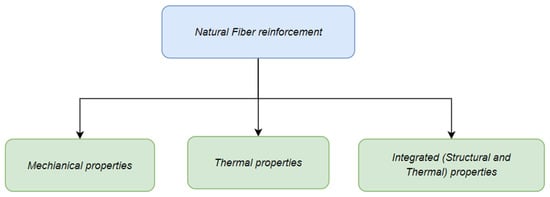
Figure 2.
The use and application of natural fiber reinforcement.
The application of natural fibers as insulation materials and in composite materials, including natural fiber composite mortar (NFCM) [24], natural fiber-reinforced polymers (NFRPs) [26], and natural fiber textile-reinforced mortar (NFTRM) [27], have demonstrated significant effectiveness in the retrofitting of masonry structures. Notably, NFCM and NFTRM have recently gained attention for their environmental benefits and improved integrated (mechanical and thermal) properties [27].
3.1.1. Mechanical Properties
Natural fiber-based building materials notably have good compressive, flexural, and tensile strength. Their lightweight and flexible properties help minimize cracking and deformation, making them exceptionally suitable for sustainable construction practices.
Kumar, A.S., and Gopi, R. (2021) [64] used rice husk ash (RHA) (in various fiber percentages: 5%, 10%, 15%, and 20%), cement, different aggregates, superplasticizers, and water to prepare composite samples, and applied RHA as a partial replacement for cement. It was observed that the flexural strength increased for samples with 5% and 10% RHA from 5.31 MPa to 5.54 MPa and 5.85 MPa, respectively. Meanwhile, for the 15% and 20% RHA, the flexural strengths were reduced to 5.23 MPa and 4.6 MPa, respectively. On the other hand, improvements in compressive strength of about 5.19 MPa, 9.67 MPa, and 1.61 MPa were noted for samples with 5%, 10%, and 15% RHA, respectively. In the sample with 20% RHA, the compressive strength was reduced by −5.74 MPa.
Quite similar to the above, Jethy et al. (2022) [65] prepared an innovative sustainable concrete mixing rice husk ash (RHA) (in various fiber percentages: 5%, 7.5%, 10%, 12.5%, and 15%), with about 25% recycled coarse aggregate (RCA), cement, different aggregates, and water. As reported by the authors, with the addition of RHA, initially, the compressive strength (test conducted on the 28th day) increased slightly, about 0.5 MPa for 5% RHA, but subsequently, the value reduced by about 1.2 MPa and 3 MPa for 10% and 12.5% RHA, respectively.
The mechanical properties of bamboo fiber (Figure 3) composite mortar mixture were studied by Maier et al. (2020) [66]. The authors used fly ash (in place of Portland cement) and recycled bamboo fiber (an industrial by-product) to prepare the composite mixture. Two fiber lengths (0.3 mm and 0.5 mm) and fiber percentages of 4%, 6% and 8% of the total mixture volume were used for the composite mortar fabrication. Reductions in compressive (about 11.0 MPa considering all samples) and tensile strength (about 1.7 MPa considering all samples) were reported, while an improvement in the crack-bridging effect (particularly with higher fiber percentage) was observed. As reported in the paper, the toughness of the composite samples was also noted.
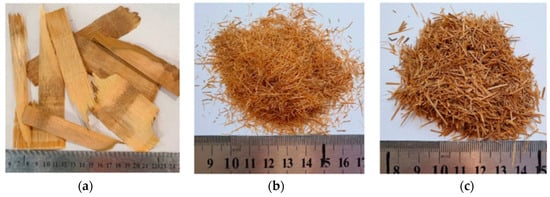
Figure 3.
Bamboo waste fiber: (a) raw fibers, (b) chopped fiber type B1 (300 μm) and (c) chopped fiber type B2 (500 μm) [66].
Interestingly, Sassu et al. [67] used a vibro-compression procedure to fabricate different block specimens with hemp (two fiber lengths), cork granulates, and natural hydraulic lime with varying percentages of fiber–mortar (Figure 4). The average flexural strength and compression strength for the hemp–lime combination were reportedly between 0.299 MPa–0.484 MPa and 0.414 MPa–0.622 MPa, respectively, while for cork–lime combinations, the flexural strength and compression strength were about 0.450 MPa and 0.732 MPa, respectively.
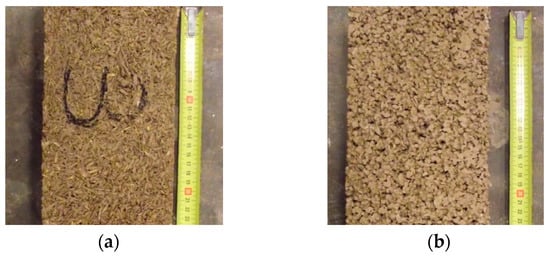
Figure 4.
(a) Hemp–lime specimen and (b) cork–lime specimen [67].
Formisano [68] studied composite hemp fiber mortar and brick samples’ physical properties and mechanical behaviors (bending and compression tests). Composite mortars were prepared with hemp fibers using four different fiber percentages: 2.0%, 1.5%, 1.0%, and 0.5%. The authors stated that the stress reduction and ultimate displacement increment were found to be about 0.09 MPa and 0.14 mm, respectively. Due to the presence of fiber and the stitching effect, the samples’ behavior changed from brittle to ductile, and according to the authors, the performance increased by about 29%.
The hemp fiber bricks were prepared with 6 mm and 15 mm long shives, silica and volcanic sands, and hydrated lime; the authors changed the shive percentages to 2% when preparing the mixtures. For composite bricks, the ultimate compression strength was 30% lower than that of commercial proton bricks.
3.1.2. Thermal Properties
Natural fiber-based building materials are mainly used to improve the insulation properties of targeted building systems. They are known to have low thermal conductivity, providing excellent insulation properties by minimizing heat transfer. Their porous structure enhances temperature regulation and energy efficiency, while their thermal capacity helps stabilize indoor climates, making them a sustainable choice for energy-efficient construction.
In Azhary et al. (2017) [69], the authors presented the measured thermal conductivity (TC) values of unfired clay–straw composite blocks (Figure 5). The composite mixtures were prepared by mixing 2%, 3%, 4%, and 5% fiber with respect to the unfired clay mass, and the insulation capacity of these composite samples improved with the increase in fiber percentage, demonstrated with reductions in TC values of 0.099 (W/mK), 0.146 (W/mK), 0.198 (W/mK), and 0.241 (W/mK), respectively for the abovementioned fiber percentages.

Figure 5.
Straw–clay composite blocks with various percentages of fiber [69].
Majumder et al. (2021) studied [48] the thermo-insulation properties of natural fiber composite retrofitting plasters and natural fiber composite building insulation materials. Table 1 presents the TC values of these composite materials.

Table 1.
Thermal conductivity values of various natural fiber composite samples [48].
In a separate study, Majumder et al. (2023) [47] fabricated four types of insulation materials intended for thermo-acoustic building insulation. In that study, the authors recycled jute, wool, and loofah fibers, and they used polyester and co-polyester and clay as binding materials. The measured TC values are summarized in Table 2.

Table 2.
Thermal conductivity values of various natural fiber samples [47].
Table 2.
Thermal conductivity values of various natural fiber samples [47].
| Insulation Materials | TCavg. (W/mK) |
|---|---|
| Jute, wool, and polyester and co–polyester (Figure 6) | 0.043 |
| Jute and clay | 0.116 |
| Loofa and clay | 0.108 |
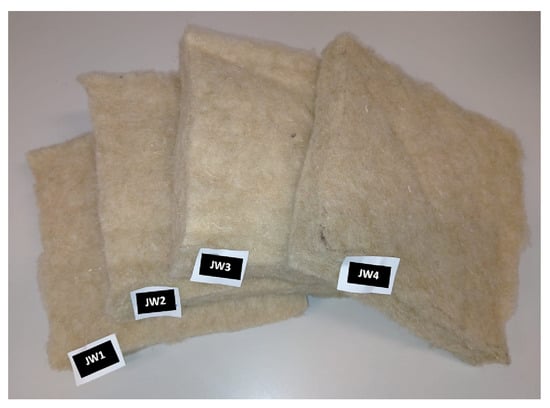
Figure 6.
Jute–wool fiber insulation panels [47].
Fatma et al. (2019) [70] prepared doum palm fiber gypsum composite mortar intended to be used in buildings as thermal insulators. Combinations of three different fiber lengths (0.1 mm, 0.2 mm, and 0.3 mm) and five fiber percentages (0.5%, 1.0%, 1.5%, 2.0%, and 2.5%) were used for the composite mortars. The authors chemically treated the fibers to remove the weak boundary layer, and the treated fibers had higher tensile strength. Notably, composite mortar with treated fibers had better compressive and flexural strength than composite mortar prepared with non-treated fibers. In all cases, the mechanical properties decreased with the increase in fiber percentages. On the other hand, this chemical treatment affected the thermal conductivity values of the composite mortars, which increased in most cases. Therefore, the insulation properties of the building materials fabricated with the treated fiber composite mortar were compromised.
Vėjelis et al. (2024) [71] examined the performance of natural fiber-based thermal insulation materials made from sheep wool (SW), wool and hemp (SW/HF), and hemp (HF), using polylactide (PLA) fibers as a binder (Figure 7). Key findings included thermal conductivity ranging from 0.0333 to 0.0438 W/(m·K), tensile strength between 2.5 to 130 kPa, and short-term water absorption from 0.5 to 8.5 kg/m2. All materials were flammable; however, the application of hydrophobic agents and flame retardants significantly reduced water absorption and flammability.

Figure 7.
(a) Sheep wool panel, (b) hemp panel, and (c) sheep wool–hemp [71].
Cetiner and Sheab (2018) explored in [72] wood waste as a natural thermal insulation material in timber walls. With a thermal conductivity ranging from 0.048 to 0.055 W/mK, it is comparable to other natural insulations and offers a low-cost, eco-friendly alternative. Hygric properties were also assessed for future modelling.
Raza et al. (2022) [73] developed a green insulation material from date palm surface fibers using polyvinyl alcohol as a binder (Figure 8). The insulation, with densities of 203–254 kg/m3, showed thermal conductivity of 0.038–0.051 W/(m·K) and thermal diffusivity of 0.137–0.147 mm2/s. It exhibited good thermal stability, a melting point of 225 °C, and reasonable tensile strength (6.9–10 MPa). The findings suggest that date palm waste can be used to create eco-friendly, cost-effective insulation alternatives to traditional petroleum-based materials.

Figure 8.
Date palm fiber panels with different densities: (a) sample A (203 kg/m3), (b) sample B (227 kg/m3), (c) sample C (246 kg/m3), and (d) sample (254 kg/m3) [73].
3.1.3. Thermo-Mechanical Properties
Natural fiber-based building materials offer enhanced mechanical and thermal properties. Therefore, they can be used for integrated retrofitting/upgrading purposes.
Aigbomian, E.P. and Fan, M. (2013) [74] used sawdust, waste paper, and traditional lime to fabricate wood concrete. The authors reported testing both thermo-mechanical properties. Notably, these building materials showed good insulation properties, with thermal conductivity values ranging from 0.045 (W/mK) to 0.070 (W/mK). Compressive strengths obtained a range from 0.06 MPa to 0.80 MPa.
Batool et al., (2021) [75] prepared sawdust concrete materials, and as reported by the authors, the mechanical properties were reduced proportionately due to the addition of sawdust. On average, a reduction in compressive strength was observed from 28 MPa to 4.5 MPa for the reference without any sawdust and 60% sawdust, respectively. Similarly, a reduction in flexural strength was observed from about 5.5 MPa (on the 28th day) to lower than 1 MPa for the reference sample without any sawdust and 60% sawdust, respectively.
In this case, Elfordy, S. et al. [41] used hemp shives/hurts and lime to fabricate concrete blocks, nominated as hempcrete. Considering the large imbibition capacity of the hemp fiber and the longer sample drying time, the authors proposed sample preparation using the projection process. The authors conducted compressive and flexural strength tests to determine the samples’ mechanical properties and calculated TC values. They reported that all values notably increased with the increase in sample densities; from about 0.12 W/mK (for about 425 kg/m3) to 0.45 W/mK (for about 550 kg/m3) for the TC values, from 0.832 MPa (for 430 kg/m3) to 1.191 MPa (for 607 kg/m3) for the flexural strengths, and from 0.180 MPa (for 291 kg/m3) to 0.40 MPa (for 485 kg/m3) for compression strengths.
Sathiparan et al. (2017) [76] prepared coconut core–cement–lime plaster composite mortar and evaluated the samples’ physical and mechanical properties (100 cubes and 15 beam prisms). The mixtures have been prepared using coconut coir (0.125%, 0.25%, 0.50%, or 0.75%), cement, lime, and sand. Notably, the composite samples with more than 0.50% fiber content showed reductions in their flexural and compressive strengths. As reported by the authors, the compressive strength values ranged between plus and minus 6% in relation to the reference mortar’s compressive strength value (2.78 MPa). With 0.5% and 0,75% of fiber in the composite samples, the flexural strengths increased and decreased by 6% and 16.5%, respectively. Therefore, samples with coir fibers have shown ductile behavior and are responsible for excellent energy absorption capacity and improved post-peak behavior.
Majumder et al. (2023) [55] studied the thermo-mechanical properties of jute fiber composite mortars (Figure 9); composite mortars were prepared using various fiber percentages (2%, 1.5%, 1%, and 0.5% based on the measured mortar mass) and fiber length (30 mm, 10 mm, and 5 mm). The authors reported testing the thermal behaviors under different environmental conditions, and they observed that with an increase in fiber percentage and a decrease in fiber length, the TC value decreased. They demonstrated that the TC value also reduced with the reduction in moisture content. This reduction in TC value confirmed the improvement in the insulation capacity of the composite material. With the addition of fiber, the mechanical behaviors (flexural and compressive strengths) were compromised, while the strain energy capacity of the composite samples improved, yielding flexural and compressive ductile behaviors compared with normal mortar without fibers.

Figure 9.
Thermal conductivity test: (a) Sample (160 mm × 140 mm × 40 mm) used for thermal conductivity measurement, (b) sample placed within the woolen heat guard inside the heat flow meter, Flexural strength tests:: (c) sample (160 mm × 40 mm × 40 mm) without fiber, and (d) sample (160 mm × 140 mm × 40 mm) with fiber (30 mm) [55].
Jiang et al. (2020) [58] examined agricultural and forestry waste (poplar leaf) fibers (Figure 10a), wheat straw fibers (Figure 10b), and rice straw fibers (Figure 10c) as organic thermal insulation components in cement-based composite thermal insulation mortar. Adding plant fibers reduced fluidity but improved mixture homogeneity. Water absorption increased by up to 15.84%, while thermal conductivity decreased (indicating improvement in the insulation properties) by up to 0,17, 0,19, and 0.20 W/(m·K), respectively. However, flexural and compressive strengths dropped by up to 3.99, 2.63, and 2.44 MPa and 20.91, 17.13, and 19.25 MPa, respectively.

Figure 10.
Agricultural and forestry wastes: (a) Poplar leaf fibers, (b) Wheat straw fibers, and (c) Rice straw fibers [58].
Valenza et al. (2015) [33] fabricated cement matrix using scrap sheep wool (from Sicily) at various percentages, and the thermal insulation and the mechanical properties of the samples were studied. For these composite mixtures, the authors used three different sizes of washed and un-washed sheep wool (Figure 11). The study showed that sheep wool can be used to reinforce building mortars, reducing thermal conductivity, especially with 6 mm fibers. Unwashed wool also helps by creating air bubbles. Optimal mechanical properties were achieved with 6 mm fibers at 13% content.

Figure 11.
Sheep wool fibers: (a) 20 mm, (b) 6 mm, and (c) 1 mm [33,58].
3.2. Natural Fiber Reinforced Polymers (NFRP)
Man-made fibers (like glass-FRP [77,78,79], carbon-FRP [80,81,82], basalt-FRP [83,84,85], etc.) are mainly used in construction and building as well as in various industries, such as automotive and aerospace [86], but NFRPs are slowly becoming a sustainable alternative to the traditional man-made fibers.
Natural fiber-reinforced polymers (NFRPs) are composite materials made by embedding natural fibers into a polymer matrix [87]. The polymer matrix is mainly made from materials like epoxy resin [88], polyester [89], or bio-based resins [90], which hold the fibers in place and transfer stresses across the material. NFRPs have multiple advantages/several benefits, such as being lightweight, relatively strong, improved mechanical properties (like tensile strength and stiffness), reduced environmental impact, and increased biodegradability compared with synthetic fiber composites [91]. NFRPs’ versatility, eco-friendliness, and ability to be sourced from renewable materials make them an attractive option for green building and sustainable development. Various research continues to explore and improve the performance of NFRPs, addressing challenges like moisture absorption [92], fiber-matrix bonding [93], and long-term durability [94] to make them even more effective and widely applicable in construction and other industries.
Codispoti et al. (2015) [95] explored the use of natural fibers—flax, hemp, jute, sisal, and coir—for strengthening masonry structures as an eco-friendly alternative to traditional composites. The fibers were tested for physical and mechanical properties, and the best performers were combined with different matrices to form composites. The results offer valuable data on the potential of natural fibers in sustainable construction. Figure 12 presents the comparative tensile strengths and Young’s modulus of different samples reinforced with various strengthening techniques.
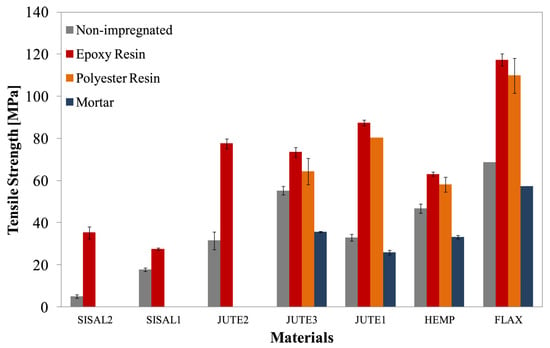
Figure 12.
Tensile strengths of different samples reinforced with various strengthening techniques [95].
Khaleel et al. (2021) [96] compared the compressive and flexural strength of brick masonry reinforced with textile-reinforced mortar (TRM) and fiber-reinforced polymer (FRP). The study utilized jute fibers of two distinct thicknesses, designated as F1 and F2, respectively. Results showed that the effectiveness ratio for compression tests on English bond prisms was 1.13 and 1.06 for F1 fiber, and 1.34 and 1.14 for F2 fiber, favoring FRP. A significant difference was also observed in flexural strength, with FRP outperforming TRM.
Yinh et al. (2021) [97] investigated the effect of natural sisal fiber-reinforced polymer composites on the strength and ductility of reinforced concrete elements. The compressive and flexural behavior of small-sized concrete specimens (cylinders and beams) strengthened with natural sisal FRPs were analyzed (Figure 13). The study found that sisal FRPs significantly improved the strength and ductility of confined concrete cylinders, while sisal FRP strengthening reduced the ductility of the beams due to sudden debonding.
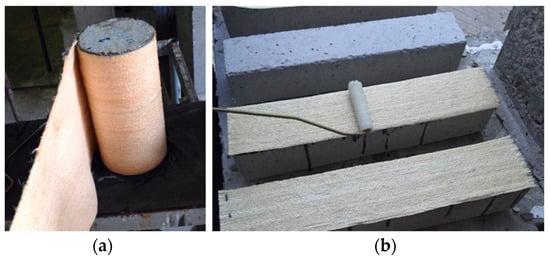
Figure 13.
Sisal FRP used for (a) cylinder and (b) beam strengthening [97].
Saidi et al. (2023) [98] examined the bond strength between natural fiber-reinforced polymer (NFRP) and concrete using four fiber types (jute, silk, pineapple, and abaca) and three adhesives (epoxy, polyester, and thixotropic epoxy) (Figure 14a). Results showed that abaca provided the strongest bond, followed by jute and silk, while pineapple fibers were the weakest. Standard epoxy resin gave the best bond, and denser fibers outperformed non-dense ones. When multiple fabric layers (two or three) were used, the bond strength, stiffness, and toughness increased significantly, with improvements ranging from 143–276% and 257–691%, respectively; 118–350% and 312–400% respectively; and 136–440% and 199–667% respectively; depending on the fabric and adhesive.

Figure 14.
(a) Jute fabric, (b) silk fabric, (c) pineapple fabric, (d) abaca non-dense fabric, and (e) abaca dense fabric [98].
Amalia et al. (2023) [99] evaluated the bonding behavior of pineapple and silk fiber-based natural fiber-reinforced polymer (NFRP) in reinforced concrete (RC) beams. Results showed that with three layers of NFRP, the maximum load increased by 2.5% for pineapple and 4.2% for silk fibers compared with the un-strengthened beams. Bond stress also increased with more fiber layers, and the fiber type impacted the performance of the strengthened beams.
3.3. Natural Fiber Textile Reinforced Mortar (NF-TRM)
Very recently, the textile-strengthened mortar (TSM) and textile-reinforced mortar (TRM) techniques have commonly been utilized for structural strengthening, with TRM being more suitable for masonry interventions.
In Italy, these inorganic matrix composites are referred to in government documents as fiber-reinforced cementitious matrix/mortar (FRCM). Within scientific, professional, and research communities, these composites are commonly known as textile-reinforced concrete (TRC) or fabric-reinforced mortar (FRM) and sometimes referred to as inorganic matrix–grid (IMG) composites.
These inorganic matrix composites are created by combining man-made or natural fibers nets or fabrics with an inorganic matrix mortar (lime-based or cement-based). Commercially, man-made nets and fabrics woven with carbon, glass, aramid, steel fibers, and PBO (polyparaphenylene benzobisoxazole) are commonly used for structural rehabilitation interventions.
TRM systems are well suited for upgrading or retrofitting masonry structures due to their higher deformation capacity [100] and high strength-to-weight ratio (this ratio ensures that structures experience minimal added weight while still benefiting from significant tensile strength) [101], therefore enhancing the overall mechanical performance and reducing stress concentration due to higher compatibility between TRM and masonry [102].
As highlighted in [103], composite and masonry substrates exhibit stronger chemical and physical affinity. Moreover, system performance remains excellent even after exposure to fire [104].
Currently, there are no specific standards for designing, testing, and qualifying TRM systems [103,105] except standards and guidelines established by the United States and the Italian National Research Council, notably the RILEM TC 250-CSM (2016) [106] ACI 549.4R-13 (2013) [107], and CNR-DT 215 (2018) [9], respectively.
The use of TRM systems for upgrading and retrofitting masonry buildings and structures is becoming increasingly common in the construction and building (CB) sector. Recently, TRM retrofitting or upgrading has emerged as a widely accepted technique for strengthening masonry structures, offering several well-known advantages over FRP systems. As a result, it has become a strong competitor to FRP-based retrofitting methods (Table 3).

Table 3.
Several pros of TRM over FRP systems.
According to the recommendations provided in CNR DT 215 (2018) [9], the following measures can be adopted to enhance the in-plane shear capacity of masonry walls:
- Apply TRM reinforcement symmetrically on both faces of the masonry wall.
- It is preferable to apply the TRM over the entire surface of the wall; however, in certain cases, application in strips may be considered.
- The fabric used should have a grid orientation aligned both vertically and horizontally.
- For crack mitigation, the fabric should be applied in the orthogonal direction relative to the cracks.
- It is important to note that, for the design of shear strengthening, only the fiber area aligned parallel to the direction of the shear force should be taken into account.
- If strengthening is applied to just one side, connectors may be used, and a reduction of at least 30% in masonry shear strength must be taken into account.
Figure 15 shows some of TRM retrofitting/upgrading schemes that are generally used for strengthening the masonry wall or structures. In some cases, the TRM may have multiple diatons/traversal connectors, depending on the surface area on which the textile/fabric has to be applied.

Figure 15.
TRM system (a) without diatons, (b) with 4 diatons, (c) with 5 diatons, (d) with 6 diatons, and (e) with 9 diatons.
According to CNR DT 215 (2018) [9], TRM can be utilized for various masonry retrofitting or upgrading applications., as summarized in Table 4.

Table 4.
TRM retrofitting/upgrading strategies [9].
3.3.1. Types of Shear-Bond Failure for TRM Strengthening
As highlighted in CNR DT 215 (2018) [9] and Ferrara et al. (2020) [42], there are mainly three types of failures observed in TRM (textile-reinforced mortar)-strengthened elements: debonding, slippage, and textile failure. These failures occur due to the interaction between the substrate and the strengthening matrix when an external load is applied.
Figure 16 presents several cases of failure in TRM strengthening. In Case 1, Figure 16a, the rupture occurs because of shear failure, without debonding, and the substrate collapses into two, while one of the pieces remains attached to the TRM matrix. In Case 2, Figure 16b, the TRM matrix (textile and mortar) becomes separated/detached from the substrate due to a loss of adhesion between the matrix and the substrate. Figure 16c represents Case 3, in which the textile detaches from the outer layer of mortar, while another section of the mortar remains adhered to the substrate. Figure 16d represents Case 4, where the TRM matrix’s embedded textile slips between the two mortar (inner and outer) layers. Figure 16e depicts Case 5, which presents an intriguing situation where both the slipping of the textile and the disintegration of the mortar matrix’s outer layer are evident. Figure 16f illustrates Case 6, which shows the tensile failure of the textile outside the matrix. Figure 16g represents Case 7, similar to Case 6, where the textile’s tensile failure within the matrix can be observed.
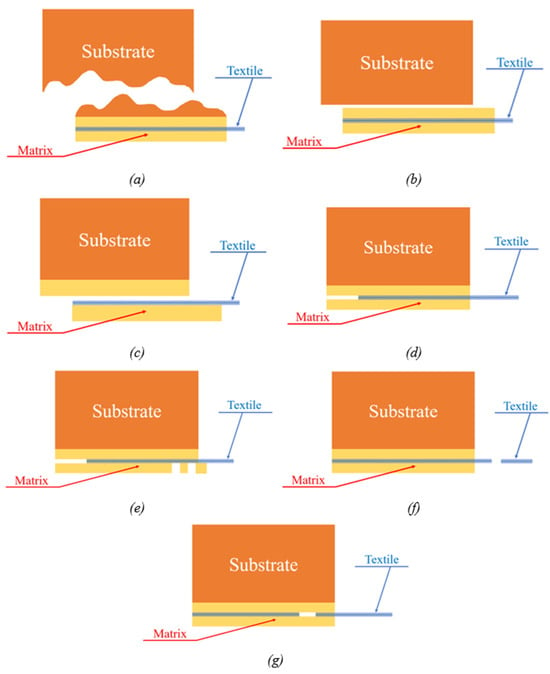
Figure 16.
(a) Failure the support without debonding; (b) debonding at the matrix-to-substrate interface; (c) debonding at the matrix-to-textile interface; (d) slippage of textile within the matrix; (e) slippage of the textile and cracking in the matrix; (f) tensile failure of the textile; and (g) tensile failure of the textile within the matrix (reproduced from [9,42]).
3.3.2. Natural Fiber TRM Application
Natural fiber textile-reinforced mortar (TRM) applied to masonry systems offers an eco-friendly and effective method for enhancing the structural integrity and durability of brick, stone, or concrete walls. By embedding natural fibers, such as jute, hemp, or flax, into the mortar mix, TRM improves the tensile strength and crack resistance of masonry surfaces, compared with an un-strengthened wall. This reinforcement can reduce the effects of weathering, moisture penetration, and mechanical stress, extending the lifespan of masonry structures. Additionally, the biodegradable nature of natural fibers makes TRM a sustainable solution, offering both environmental and practical benefits in the repair and maintenance of masonry systems.
Notably, there are various limitations to using the NFTRM system in a real-life scenario due to the following:
- Durability Issues: One of the major problems of natural fibers in a TRM system is durability, which has not been extensively studied yet. Therefore, effective treatment protocols are needed to enhance their longevity and performance.
- Crimping Effects: The crimping effect in natural fibers affects their tensile response, requiring to be taken into account for effective composite use;
- Dimensional Stability: importantly, natural fibers are not uniform in nature and therefore, ensuring the dimensional stability of natural fibers in TRMs is another significant challenge;
- Empirical Fabrication: The current production of natural TRMs predominantly relies on empirical methods rather than a systematic engineering design approach;
- Compatibility with Matrix Materials: It is crucial for optimal performance that the appropriate choice of the type of matrix that should be compatible with the natural fibers in terms of stiffness and strength.
- Lack of Rational Design Methodology: A rational, theoretical approach to designing natural TRM composites is necessary, as there are currently no standardized methodologies for accurately predicting properties.
- Need for Further Research: Existing research in this field is limited; therefore, future research should focus on improving the performance and design of natural fiber TRM systems.
Codispoti et al. (2015) analyzed the mechanical behavior of natural fiber-reinforced cementitious matrices (NFRCMs) [95]. During this experimental campaign, jute fabric (Figure 17a), sisal fabric (Figure 17b), hemp fabric (Figure 17c), and flax fabric (Figure 17d) were used along with an inorganic mortar prepared from pozzolana lime and natural siliceous material with a maximum diameter of 2 mm. Figure 17e shows one of the NFRCM samples after it experienced tensile failure.
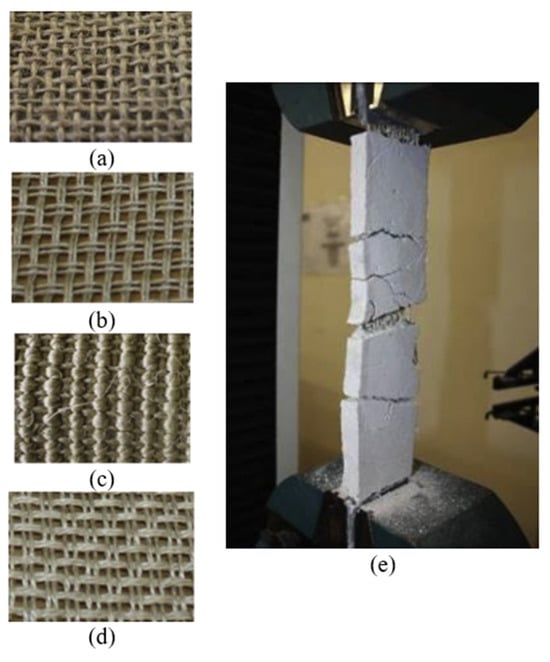
Figure 17.
Some natural fiber fabrics: (a) jute, (b) sisal, (c) hemp, (d) flax and (e) NFRCM sample [95].
Trochoutsou et al. (2021) [111] studied the mechanical behaviors of flax–TRM and jute–TRM systems, showcasing the potential of the jute fiber-based NFTRM system for structural applications. They found that flax textiles with smaller diameter, twisted yarns, and denser mesh performed best when the reinforcement ratio exceeded 3%. These composites showed high strength (80–200 MPa) and elongation (4–8%), making them a promising, sustainable solution for masonry retrofitting, offering good compatibility and moderate stiffness.
Khleel, S.H. et al. (2021) [96] compared the mechanical properties of brick masonries strengthened with textile-reinforced mortar (TRM) and fiber-reinforced polymer (FRP). They evaluated the compressive and flexural strengths of prisms with FRP and TRM jacketing using jute textile in an inorganic cement-based mortar. The results showed that FRP was more effective than TRM in the compression tests. Additionally, FRP significantly outperformed TRM in the flexural strength tests.
4. International Standards for Masonry Testing Methods
Various standards and guidelines are available for assessing the performance of masonry structures. Below, some well known and widely used methods are discussed for the readers’ reference.
- The ASTM E519/E519M-22 standard [112] provides a comprehensive method for testing the diagonal tension (shear) strength of masonry assemblages, emphasizing consistent and precise evaluation of their structural performance (Figure 18). The test involves applying a compression load diagonally to a masonry specimen, resulting in tension-induced failure along the diagonal. This methodology allows precise evaluation of shear stress and strain, interpreting the impact of masonry unit type and mortar composition on material properties. The standard highlights the requirements for test preparation like specimen dimensions, curing conditions, number of specimens to be tested, and dimensioning of testing apparatus, in order to ensure consistency and reliability of results. Testing machines must apply continuous loads, while optional instrumentation can measure strain for a more detailed stress–strain analysis. The results include calculated shear stress, strain, modulus of rigidity, and failure modes. Developed with internationally recognized principles, the standard supports dual-unit (SI and inch-pound) measurements and ensures safety considerations during testing. It serves as a vital tool for researchers and engineers in evaluating masonry for structural behavior.
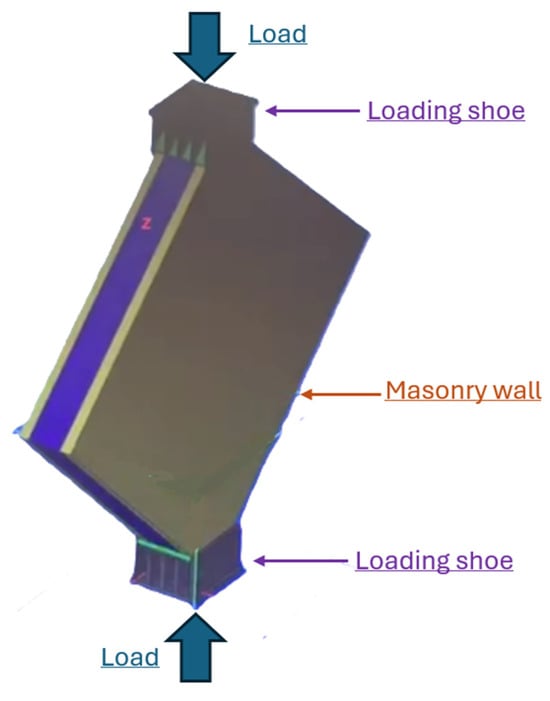 Figure 18. Diagonal test setup (reproduced from [112]).
Figure 18. Diagonal test setup (reproduced from [112]).
- The ASTM E2126-19 standard [113] provides detailed test methods for evaluating the shear resistance of vertical elements in lateral force-resisting systems under cyclic (reversed) loading conditions. This standard is designed to assess the performance of structural systems, such as walls, partitions, and other vertical assemblies, when subjected to repeated lateral loads that simulate seismic or wind forces. The test methods involve the controlled application of cyclic lateral loads to measure deformation, energy dissipation, stiffness degradation, and ultimate strength. The standard highlights reversed cyclic loading and helps simulate the structural response during load reversals. It provides guidelines for sample preparation, testing equipment, and loading protocols. The results outline essential parameters, including load–displacement behavior, hysteresis characteristics, and ductility. These parameters are essential for studying the seismic performance and ensuring the reliability of lateral force-resisting structures. This standard is extensively utilized in structural design and quality assurance to guarantee building safety and ensure compliance with established design criteria.
- The EN 1052-1:2011 [114] is a European standard that specifies the method to determine the compressive strength of masonry. It is mainly used for evaluating the load-bearing capacity and structural integrity of masonry elements, such as walls made from materials like clay bricks, concrete blocks, and natural stones, bonded with mortar. The standard gives guidance on how to prepare the test specimens, the procedure for applying compression loads uniformly, and the calculation of compressive strength, which is computed based on the maximum load at failure. This standard has been used to ensure that masonry structures comply with safety and performance standards, contributing to the overall stability and durability of buildings.
- The RILEM LUMB6 guidelines [115] provides recommendations from the International Union of Laboratories and Experts in Construction Materials, Systems, and Structures (RILEM) for conducting diagonal tensile strength tests on small masonry wall specimens. Unlike national standards such as those from the British Standards Institution (BSI), RILEM guidelines offer internationally recognized best practices. The LUMB6 procedure evaluates the shear strength of masonry by applying compression loads along a diagonal axis of wall specimens, typically measuring 500 mm × 500 mm. Key steps include preparing and curing the specimens, setting up the test frame with diagonal load application through steel plates or loading shoes, and gradually applying the load until failure, usually indicated by diagonal cracking. As recommended, the maximum load at failure is recorded, and the diagonal tensile strength is calculated using the load, specimen dimensions, and contact area. This testing method is essential for understanding the tensile and shear properties of masonry, which are crucial for designing and evaluating structures, especially under lateral loads such as seismic forces.
5. Masonry Wall Testing
Different TRM-system-reinforced masonry techniques and experimental testing methodologies are described in this section, including (i) diagonal tension (shear) tests, (ii) in-plane cyclic tests, and (iii) compressive strength tests. Notably, some examples are provided here based on the above-mentioned standards and guidelines mentioned in Section 4.
The performance of masonry walls can be assessed through a variety of tests, particularly including the following.
5.1. Diagonal Tension (Shear) Test
This test is designed to assess the shear strength of masonry walls. A diagonal load is applied to the wall, creating a shear stress that simulates the forces experienced during seismic events or lateral loads. The test helps determine the wall’s ability to resist diagonal cracking and shear failure.
Yu, J.-H. and Park, J.-H. (2021) [116] reinforced masonry walls with amorphous steel fiber-reinforced mortar (ASFRM) and evaluated their structural performances through compression and diagonal tension (Figure 19) tests. As the authors reported, the ASFRM often detached after reaching peak strength. Further bond strength tests and predictive equations for compressive and tensile strengths were developed, considering stress distribution and bonding effects. The authors reported an increment in diagonal tensile strength between 628% and 2660% for different retrofitting schemes (on single or both sides).
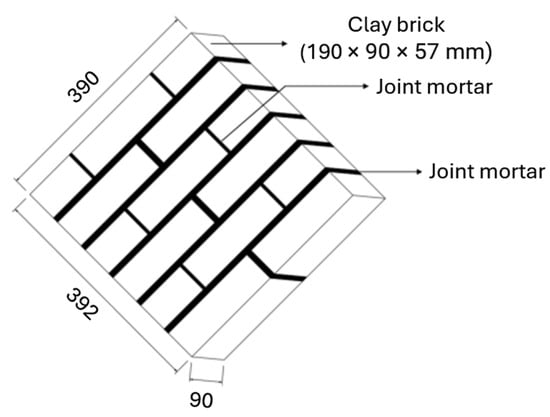
Figure 19.
Masonry wall used for the tensile strength test [116].
Thomoglou et al. (2022) [117] investigated the effectiveness of glass fiber textile-reinforced mortar (TRM) for strengthening un-reinforced masonry (URM) wall panels. To assess their in-plane behavior, eight brick walls (two with and five without central openings) were tested under diagonal tension.
Longo et al. (2021) [118] performed diagonal shear tests on integrated retrofitted masonry walls (Figure 20).
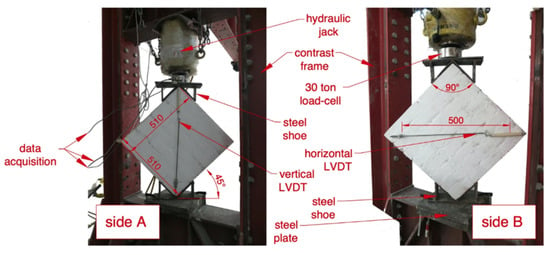
Figure 20.
Diagonal shear test setup [118].
5.2. In-Plane Cycle Test
This test evaluates the wall’s behavior under cyclic loading conditions, simulating repeated lateral forces. The in-plane cycle test helps to understand the wall’s capacity to withstand in-plane deformations, energy dissipation, and its overall durability under dynamic loading conditions.
Elmeligy et al. (2025) [119] examined how increasing the shear span-to-depth ratio (M/(Q × dv)) enhanced the cyclic performance of partially grouted reinforced masonry shear walls (PG-RMSWs). Testing on two walls with different ratios (2.54 and 5.08) revealed that higher ratios improved ductility, stiffness, damage control, energy dissipation, and overall behavior, demonstrating the PG-RMSWs’ suitability for taller buildings.
Another study (Mohamad et al. (2017) [120]) examinedthe inelastic behavior of self-insulating concrete masonry shear walls (SCMSWs) under in-plane cyclic loading (Figure 21). SCMSWs made from specially configured concrete blocks for enhanced bonding were tested with varying heights (1.59 to 5.78 m), vertical steel configurations, and axial load ratios. Results indicated lateral load capacity increases with higher axial loads and vertical reinforcement but decreases with larger wall aspect ratios. The inclusion of boundary elements enhances ductility and lateral load capacity. SCMSWs demonstrated predominantly flexural behavior, aligning with findings for walls using ordinary masonry units.
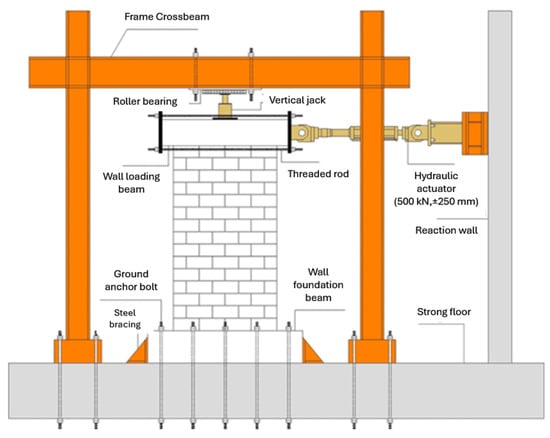
Figure 21.
Masonry wall in-plane cyclic test [120].
In Majumder et al. (2024) [27], masonry walls were subjected to cyclic horizontal loads from the right (H3) and the left (H2), as shown in Figure 22. After the cycles, an increasing load was applied until collapse. Each wall had three displacement transducers: two on the front for diagonal displacements and one on the back for horizontal displacements.
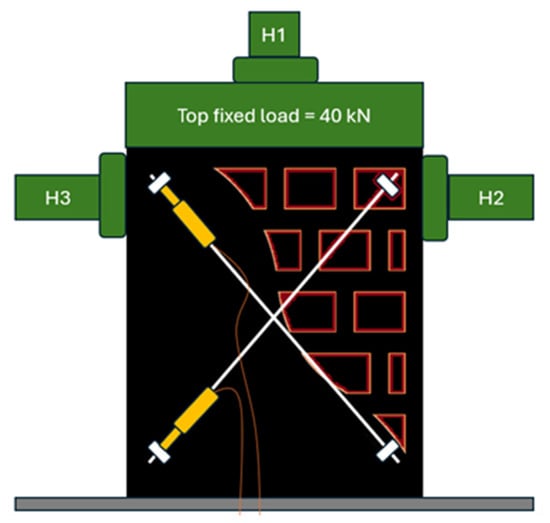
Figure 22.
Masonry wall in-plane cyclic load test scheme.
5.3. Compressive Strength Test
This test measures the maximum compressive strength of the masonry wall by applying a vertical load until failure. It provides insights into the wall’s ability to bear vertical loads, its structural stability, and its capacity to support the weight of the building and any additional loads.
Yu, J.-H. and Park, J.-H. (2021) [116] reported an increment in compressive strength (Figure 23) between 11.2% and 121.9% for different retrofitting schemes (on single or both sides) of reinforced masonry walls with amorphous steel fiber-reinforced mortar (ASFRM).
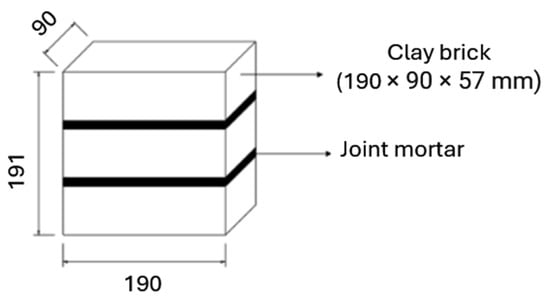
Figure 23.
Masonry wall used for compressive testing [116].
In Radovanović et al. (2015) [121], testing of compressive strength and elasticity modulus was performed under the conditions defined in the standard EN 1052-1: 2011 [95]—Test methods for masonry—Part 1: Determination of compressive strength.
6. Masonry Wall Structural Upgrade with Natural Fiber TRM Systems and Testing
Notably, very little research has been conducted on the use of NFTRM systems for masonry strengthening, and consequently, relevant findings are also very limited. Illampas et al. (2023) [122] underlined several drawbacks of TRM–masonry application, as follows:
- Durability Issues: One of the major problems of natural fibers in a TRM system is durability, which has not been extensively studied. Therefore, effective treatment protocols are necessary to enhance longevity and performance;
- Crimping Effects: The crimping effect in natural fibers affects their tensile response, requiring taking into account for effective use of composites;
- Dimensional Stability: Natural fibers are not uniform in nature, so ensuring the dimensional stability of natural fibers in TRMs is another significant challenge;
- Empirical Fabrication: The current production of natural TRM predominantly relies on empirical methods rather than a systematic engineering design approach;
- Compatibility with Matrix Materials: It is crucial for optimal performance that the appropriate choice of the type of matrix should be compatible with the natural fibers in terms of stiffness and strength.
- Lack of Rational Design Methodology: A rational, theoretical approach to designing natural TRM composites is necessary, as there are currently no standardized methodologies for accurately predicting properties.
- Need for Further Research: Existing research in this field is limited; therefore, future research should focus on improving performance and designing natural fiber TRM systems.
Menna et al. (2015) [43] reinforced eight masonry panels constructed of Neapolitan yellow tuff bricks and solid clay bricks, using a hemp–TRM system [43]. This system consisted of a hemp fiber net and pozzolanic lime-based mortars. As shown in Figure 24, the authors conducted diagonal compression tests to assess the increase in the maximum shear strength of the strengthened panels.
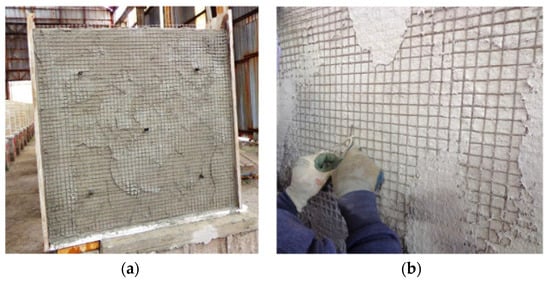
Figure 24.
Hemp fiber TRM retrofitting: (a) placement of one ply of HFC grid on each side of the panel, and (b) installation of the anchor system on each panel side [43].
Ferrara et al. (2020) developed a flax–TRM system consisting of flax fibers and hydraulic lime mortar to strengthen masonry walls made of clay bricks (Figure 25) [42]. The performance of these walls was evaluated under diagonal compression to assess their shear capacity. Two variations of the TRM system were tested: (1) a single layer and (2) two layers of fabric and mortar. The results indicated an improvement in shear capacity of 118% for the single-layer system and 136% for the double-layer system.
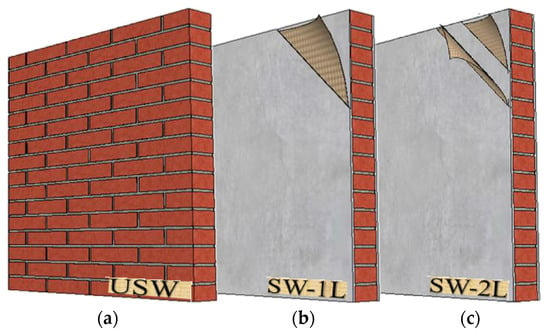
Figure 25.
Flax fabric retrofitted masonry walls: (a) un-strengthened, (b) strengthened with one textile panel, and (c) strengthened with two textile panels [42].
Khleel, S.H. et al. (2021) [96] evaluated the mechanical properties of brick masonries strengthened with textile-reinforced mortar (TRM), as illustrated in Figure 26.
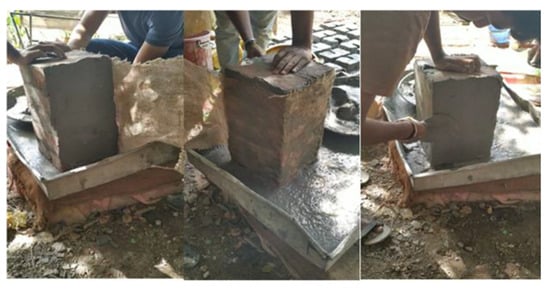
Figure 26.
Jute fiber TRM retrofitting [96].
7. Integrated TRM Retrofitting/Upgrading: Man-Made vs. Natural Fiber
7.1. Man-Made Fiber for Integrated (Structural and Thermal) TRM Retrofitting/Upgrading
Integrated (thermal and structural) upgrading plays a crucial role in improving the sustainability and resilience of existing buildings. Integrated retrofitting/upgrading is a very new concept, and this innovative approach can ensure a balanced solution by optimizing both thermal and structural retrofitting/upgrading needs of a building. Furthermore, it can address multiple other objectives such as sustainability, restoration, building health, comfort, and a lower carbon footprint. It can also extend the lifespan of a building, significantly reducing the maintenance costs, and improving safety and living conditions for its occupants.
Interestingly, in recent years, integrated retrofitting/upgrading has attracted significant research interest among scholars. As highlighted in [123], the thermal and seismic upgrading of existing walls has been achieved through the use of prefabricated textile-reinforced concrete (TRC) panels. Triantafyllou et al. (2017) [124] investigated the structural and thermal retrofitting of masonry walls, claiming to be the first to introduce the concept of combined structural and energy retrofitting. Their research focused on retrofitting masonry walls using a textile-reinforced mortar (TRM) system with various configurations. The system consisted of a cement-based mortar reinforced internally with commercially available fabric, while expanded polystyrene (EPS) and foamed cement were employed as insulation materials (see Figure 27). Improvements in the structural parameters were evaluated through out-of-plane tests. The three-point bending tests showed that the load-bearing capacity of the retrofitted walls improved significantly compared with the reference wall (peak load of 3.42 kN), and the retrofitted walls demonstrated peak loads ranging from 8.06 kN to 20.26 kN. Moreover, some samples were subjected to fire tests.
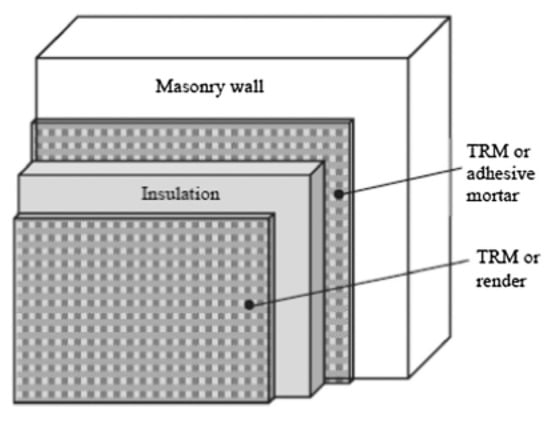
Figure 27.
Integrated retrofitting scheme [124].
Triantafyllou et al. (2018) [125] enhanced masonry wallets with a glass–TRM system for structural and energy retrofitting purposes. In their study, the authors utilized a general-purpose cement-based mortar and incorporated EPS into the TRM system. While they presented in-plane test results, they did not report any experiments related to thermal properties. Given the inclusion of insulation materials in the TRM system, it can be inferred that the thermal performance is likely to have improved. The three-point bending tests revealed notable differences in the peak load capacities between reference and retrofitted wall samples across different wall types. For the reference walls, Type A, Type B, and Type C exhibited peak loads of 19.9 kN, 20 kN, and 12.2 kN, respectively. In contrast, the retrofitted or upgraded wall samples demonstrated significantly higher peak loads, with Type A ranging from 31.5 kN to 37.5 kN, Type B from 29.2 kN to 37.1 kN, and Type C from 24.3 kN to 36.8 kN.
Gkournelos et al. (2020) [126] evaluated the structural performance of integrated retrofitted wall panels through both in-plane and out-of-plane testing, reporting notable improvements. The retrofitting system employed consisted of a glass–TRM system incorporating polystyrene insulation and general-purpose masonry mortar. However, the study did not provide any data or analysis regarding the thermal performance of the retrofitted assemblies. In the in-plane tests, the reference wall exhibited a shear strength of 0.78 MPa. In contrast, the integrated wall demonstrated a significantly higher shear strength of 1.63 MPa, representing a huge improvement in the in-plane performance of the integrated wall. Similarly, in the out-of-plane tests, the maximum average load capacity for the reference wall was 1.60 kN. In contrast, the integrated wall showed a significant increase, with an average load capacity of 25.3 kN.
Karlos et al. (2020) [127] retrofitted masonry walls using a textile-reinforced mortar (TRM) system that consisted of glass fiber fabric, cementitious mortar, and an expanded polystyrene (EPS) plate, which served as a protective insulating layer. Although the study did not provide experimental data on thermal performance, improvements were expected due to the inclusion of EPS. The authors performed out-of-plane tests, as well as developed analytical and numerical models. The results revealed notable enhancements in both the strength and deformation capacity of the walls that underwent retrofitting. The three-point bending tests revealed a significant increase in peak load capacities for retrofitted wall samples when compared with the reference wall. The reference wall recorded a peak load of 3.42 kN. In contrast, the retrofitted walls demonstrated peak loads ranging from 9.28 kN to 20.26 kN.
Baek et al. (2022) [128] proposed an innovative thermo-structural retrofitting technique that combined structural reinforcement with thermal enhancement. The system employed basalt–TRM for structural upgrading and incorporated a novel textile capillary tube panel (TCP) layer to enhance the thermal insulation of the masonry wall. The TCP system was designed to circulate hot water through the capillary tubes, thereby contributing to maintaining the desired indoor temperature. The experimental results indicated a significant enhancement in lateral load capacity for masonry walls reinforced with textile capillary tube panel (TCP) systems compared with the reference wall. The reference wall exhibited an average lateral load capacity of 52.7 kN. In contrast, the TCP-reinforced masonry wall achieved a higher capacity of 74.55 kN, while the TCP–textile-reinforced mortar (TCP-TRM) reinforced wall demonstrated an even greater capacity of 119.15 kN. The TCP system, which channeled hot water through capillary tubes to regulate room temperature, effectively maintained the room temperature at around 20 °C, contributing to improved in-plane (IP) performances. Enhanced structural performance was particularly noted when the TCP layer was placed internally, optimizing both thermal and load-bearing capacities of the masonry walls.
Moreover, Gkournelos et al. (2023) [129] studied masonry walls’ in-plane and out-of-plane behaviors after retrofitting with commercially available man-made fiber TRM and EPS systems. The experimental findings were compared with the numerical results. Both the in-plane and out-of-plane tests demonstrated improvements in the structural performance of integrated walls compared with the reference walls. The reference wall in the in-plane tests had a shear strength of approximately 140 kN, while the integrated wall demonstrated an increased shear strength of about 160 kN, indicating enhanced resistance to in-plane forces. In the out-of-plane tests, the reference wall showed a maximum peak load of 47.4 kN (average with and without pre-in-plane failure), whereas the integrated wall achieved a higher average peak load of 69.2 kN.
In all aforementioned integrated retrofitting/upgrading research works, as in [124,125,126,127,128,129], the authors inferred improvements in thermal insulation capacity due to the application of EPS in the TRM systems, without conducting experiments.
Facconi et al. (2021) evaluated the structural and thermal performance of an integrated retrofitted masonry system using numerical modeling and COMSOL Multiphysics software [130]. In their study, the researchers simulated masonry walls that were retrofitted with a steel–TRM system. As in Figure 28, this system consisted of cementitious materials combined with various insulation layers, including aerogel, light wood fiber, and heavy wood fiber. The full-scale building tests indicated that retrofitted walls significantly enhanced the horizontal peak force capacity, achieving the reference wall the value of 180 kN, while the retrofitted wall the value of 605 kN, showing a marked improvement in structural strength and resistance to horizontal forces. In terms of thermal performance, the analytical thermal transmittance of the reference wall was calculated at 1.038 W/m2K. In contrast, the retrofitted wall samples showed a greatly improved thermal transmittance, ranging from 0.242 W/m2K to 0.335 W/m2K (analytical) and 0.246 W/m2K to 0.336 W/m2K (numerical).
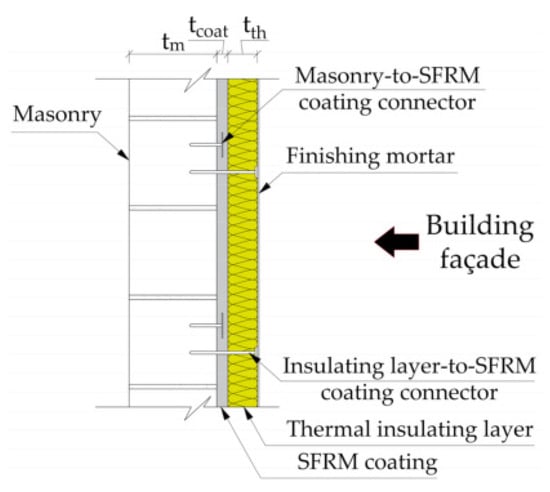
Figure 28.
Proposed retrofitting scheme [130].
Longo et al. (2021) [118] were among the first to present detailed experimental results on the integrated properties (both on structural and thermal) of masonry walls retrofitted with various configurations of TRM systems. These systems incorporated glass and steel fabrics combined with either natural hydraulic lime or geopolymer lime, as shown in Figure 29. The authors used four halogen lamps to heat one side of each wall specimen and measured surface temperatures on both sides. Based on these measurements, the thermal transmittance of each wall was calculated. The geopolymer-based TRM systems demonstrated greater ductility and enhanced thermal insulation performance. The experimental results demonstrated improvements in both shear strength and thermal performance for walls retrofitted with glass and steel fibers. The shear strength of walls upgraded with glass fibers ranged from 0.818 MPa to 1.298 MPa, while those retrofitted with steel fibers showed higher values, ranging from 1.058 MPa to 1.480 MPa. Regarding the thermal performance (Figure 30), the reference wall exhibited a thermal transmittance of 2.082 W/m2K, while the retrofitted walls demonstrated better thermal transmittance values ranging from 1.051 W/m2K to 1.562 W/m2K. This improvement highlights the effectiveness of the retrofitting process in reducing heat transfer, contributing to better energy efficiency.
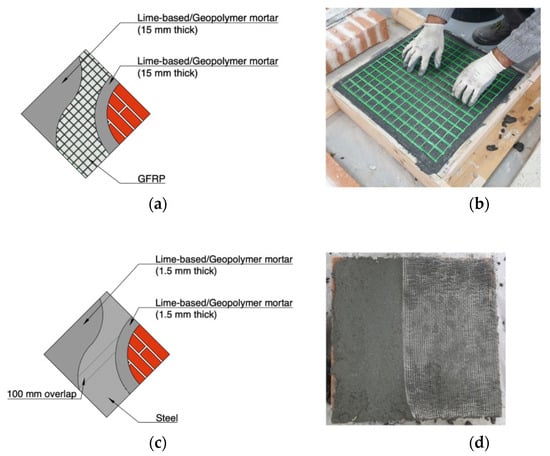
Figure 29.
Two different retrofitting schemes: (a) glass fiber TRM application scheme, (b) glass fiber TRM wall retrofitting, (c) steel fiber TRM application scheme, and (d) steel fiber TRM wall retrofitting [118].

Figure 30.
(a) Thermal performance evaluation setup: wall sample 1 and wall sample 2, (b) wall heating scheme side view, and (c) wall heating scheme front view [118].
Furtado, A. et al. (2023) [131] used glass–TRM, an external thermal insulation composite system (ETICS), and reinforced thermal insulation mortar (RTIM) in different combinations for integrated (structural and thermal) retrofitting. They reported experimental data from the out-of-plane structural tests, while the thermal transmittance values were calculated based on the thermal conductivity values of the used materials. The out-of-plane tests indicated a significant improvement in the maximum peak load capacity of retrofitted or upgraded wall samples compared with the reference wall. The reference wall exhibited a peak load of approximately 45 kN, while the retrofitted walls, utilizing EPS (expanded polystyrene), ETICS, and RTIM had peak loads ranging between 65 kN and 100 kN, demonstrating a substantial enhancement in structural resilience due to the retrofitting methods. The thermal performance of the wall specimens was evaluated by calculating the thermal transmittance. The reference wall was approximately 1.75 W/m2K, while the retrofitted wall samples exhibited significantly improved thermal efficiency, with thermal transmittance values ranging from 0.30 W/m2K to 0.4 W/m2K.
7.2. Natural Fiber for Integrated TRM Retrofitting/Upgrading
Majumder et al. (2024) [27] upgraded a masonry wall using jute fiber products (jute net, jute diatons, and jute fiber composite mortar), as illustrated in Figure 31. The experimental setup for assessing an upgraded masonry wall under in-plane cyclic loads involves applying vertical and horizontal forces initially includes a vertical load of 40 kN, about 1% of the wall’s ultimate capacity, applied via a hydraulic jack (H1) to simulate baseline axial stress. The wall then undergoes in-plane horizontal cyclic loading using two hydraulic jacks, starting with jack H2, followed by H3. After three cycles of horizontal loading, the protocol progresses to a monotonic phase, where the horizontal load increases until failure. As reported by the authors, the load-bearing capacity of the upgraded masonry wall improved by 450% (Figure 32a), whereas the thermal transmittance decreased by 36% (Figure 32b). Therefore, the strength and insulation capacity of the wall increased. Also, see Stochino et al. (2025) to learn more about NFTRM upgrading [132].
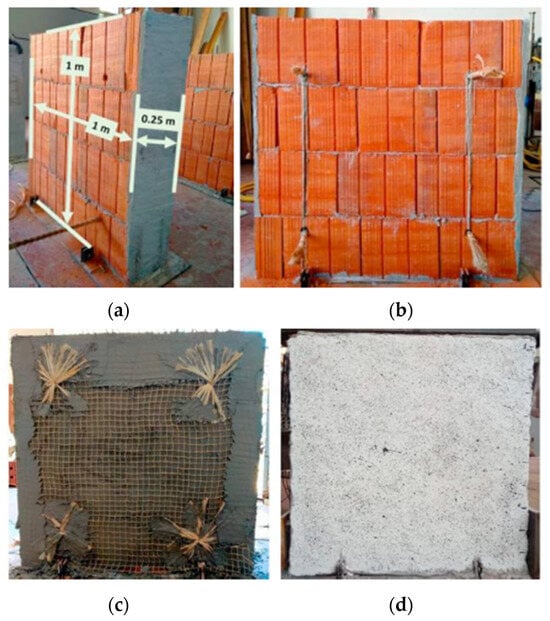
Figure 31.
(a) Un-strengthened masonry wall, (b) un-strengthened masonry wall with diatons, (c) un-strengthened masonry wall with jute fiber net and diatons, and (d) upgraded masonry wall.
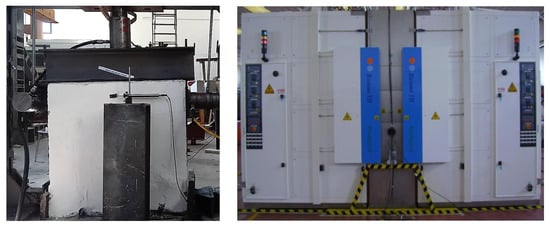
Figure 32.
(a) In-plane cyclic test, and (b) climate chamber for thermal evaluation.
8. Discussion and Observations
Notably, the type of natural fiber and the amount used during composite mortar preparation significantly influence its overall mechanical and thermal performance.
It has been observed that different fibers yield varying outcomes in terms of strength enhancement and thermal insulation, depending on their physical characteristics, interaction with the matrix, and dosage levels.
Mechanical Properties: Some fibers, such as banana, hemp, and pineapple, demonstrated a clear reinforcing effect when used in optimal amounts. Banana fiber, at 0.25% by weight of cement, improved compressive strength from 46.73 MPa to 55.45 MPa and flexural strength from 8.45 MPa to 10.98 MPa [133]. Similarly, hemp fiber increased compressive and flexural strengths significantly at 3% dosage, reaching up to 36.46 MPa and 34.67 MPa, respectively [134]. Pineapple fiber, at 5%, also improved compressive strength to 14.5 MPa [135]. Conversely, fibers such as coconut, bamboo, sheep wool, and jute, especially at higher percentages, tend to reduce compressive strength. Coconut fiber reduced compressive strength from 65 MPa to 33 MPa as its content increased to 4% [136]. Bamboo fiber exhibited a drastic reduction in compressive strength, from 38.03 MPa to 2.46 MPa at a 15% volume [137]. Similarly, jute and sheep wool fiber composites experienced consistent strength reductions as fiber content increased [33,55].
With the addition of increased amounts of natural fiber during composite mortar production, reduced thermal conductivity has been demonstrated, thereby improving the insulation performance of composite materials. Based on the literature review, it is evident that natural fibers, such as bamboo, wood, sheep’s wool, and jute, have demonstrated notable thermal advantages.
As reported in Table 5, the addition of bamboo fiber significantly reduced thermal conductivity from 1.76 W/mK to 0.719 W/mK [137], whereas sheep wool at higher fiber contents achieved thermal conductivity as low as 0.096 W/mK, highlighting its excellent insulating capability [33]. Additionally, the inclusion of wood fiber (particularly pine) resulted in improved thermal insulation, with thermal conductivity values decreasing to 0.6848 W/mK [138].

Table 5.
Thermo-mechanical strengthening.
These findings highlight the potential of fiber-reinforced materials in enhancing thermal regulation and promoting energy-efficient construction.
Notably, with certain fibers like banana, hemp, and pineapple, low to moderate fiber content (typically around 0.25–3%) tends to enhance mechanical properties. However, higher fiber volumes generally compromise strength, though they improve thermal insulation, as seen in composites with jute, wool, or bamboo. The effect of fiber type is therefore context-dependent: high-performance structural applications benefit from selective, low-dose reinforcement fibers, while thermal insulation purposes may favor higher doses of softer, more porous fibers. An optimal design should balance both strength and insulation requirements based on end-use needs.
Table 6 presents the analysis of TRM (textile-reinforced mortar) systems for thermo-structural upgrading. Notably, it reveals the trend improvements in both structural and thermal performance across a diverse range of materials. Natural fiber TRM systems, such as those using jute, demonstrated remarkable gains in structural performance, as well as showing significant thermal efficiency improvements, with a drop in the thermal transmittance value Interestingly, in most cases of TRM upgrading using man-made fibers, improvements in mechanical strength have generally been observed. However, the majority of studies often lack direct thermal testing, instead relying on assumed insulation benefits from materials such as EPS used in the TRM retrofitting system. Across the studies, systems incorporating EPS consistently indicated perceived thermal improvements. A few comprehensive studies, such as those by Longo et al. and Baek et al., explored both lateral load behavior and thermal metrics, underscoring the importance of integrated testing approaches. Overall, a clear trend indicates that TRM systems can significantly the enhance thermo-structural performance of masonry walls. But robust, experimentally verified thermal assessments remain limited and are crucial and need to be done for full implementation of the integrated system.

Table 6.
Thermo-structural strengthening.
9. Conclusions
This study provides an extensive evaluation of advanced methodologies for enhancing masonry walls’ structural and thermal performances. Notably, this review paper significantly contributes to the scientific community by compiling current retrofitting techniques into an integrated framework.
Various retrofitting approaches are discussed and reviewed, with a particular focus on sustainable masonry retrofitting or upgrading solutions, including mechanical/structural, thermal, and integrated retrofitting. We advocate using sustainable, natural, low-carbon, and greener solutions for building retrofitting/upgrading and suggest using natural fiber-based reinforcement as a viable alternative to traditional methods.
Integrating a comprehensive analysis of textile-reinforced mortar (TRM) systems and their comparison with fiber-reinforced polymers (FRPs), the current literature reports a shift towards using natural fiber textile-reinforced mortar (NFTRM) systems due to their lower environmental impact and the significant improvements they can provide in terms of masonry walls’ structural and thermal properties. Natural fibers, such as jute, hemp, and flax, are emphasized for their sustainability, reducing carbon footprint and enhancing compatibility with masonry materials over synthetic options like glass and carbon fibers.
The effectiveness of NFTRM systems in structural applications is interesting, particularly in their ability to increase load-bearing capacity and reduce thermal transmittance, which is crucial for energy efficiency and seismic resilience. NFTRM systems not only meet but exceed the performance of traditional retrofitting materials, providing a compelling argument for their broader adoption in masonry retrofitting projects.
Key areas that need to be addressed for full implementation of natural fiber-based building materials include long-term durability studies to evaluate the aging, moisture resistance, and fire performance of natural fiber textile-reinforced mortar (TRM) systems. Optimization of natural fiber processing and development of performance-based design codes is also required to support engineers in assessing the effectiveness of sustainable retrofitting solutions.
This study emphasizes the urgent need for eco-friendly retrofitting techniques aligned with sustainability goals, while advocating the use of natural fiber-based TRM systems to improve masonry structure performance, which can become a true alternative for masonry retrofitting/upgrading.
Moreover, the construction and building industry should continue exploring and optimizing the use of natural fibers in retrofitting applications. Future research should address concerns about the durability of natural fibers and expand application methodologies to enhance the practical implementation of NFTRM systems in real-world scenarios.
In conclusion, this comprehensive review establishes a strong foundation for the further development of sustainable retrofitting techniques that align with global sustainability goals and the urgent need for enhanced safety and energy efficiency in existing buildings.
The increasing demand for sustainable retrofitting solutions has led to the R&D of NFTRM systems, providing advantages such as a lower carbon footprint, enhanced breathability, and improved compatibility with masonry structures.
Notably, the NFTRM system for integrated retrofitting/upgrading is a new concept and faces several challenges, like the durability of natural fibers, which are susceptible to microbial growth, UV exposure, and degradation in alkaline cementitious matrices.
Additionally, natural fibers are known to have high moisture absorption capacity in comparison to man-made fibers, and this phenomenon can lead to a reduction in strength with time and the possibility of fungal growth may compromise the system’s long-term performance. Furthermore, NFTRM systems do not have any standardized testing protocols, guidelines, or design methodologies, which limits their acceptability for masonry retrofitting/upgrading.
To address all the aforementioned issues, future research should focus on improving fiber durability through treatments and hybrid reinforcement strategies, developing water-resistant composites, and establishing performance-based design codes.
Therefore, to promote the applicability of NFTRM systems for sustainable construction, collaborative efforts to create internationally recognized standards for testing and design will be essential.
Author Contributions
Conceptualization, A.M., F.S., M.V., G.C., M.P. and E.M.; methodology, A.M., F.S., M.V., G.C., M.P. and E.M.; validation, A.M., F.S., M.V., G.C., M.P. and E.M.; formal analysis, A.M.; investigation, A.M. and F.S.; resources, F.S. and E.M.; data curation, A.M.; writing—original draft preparation, A.M. and F.S.; writing—review and editing, A.M., F.S., M.V., G.C., M.P. and E.M.; visualization, A.M., F.S., M.V., G.C., M.P. and E.M.; supervision, F.S. and E.M.; project administration, F.S. and E.M.; funding acquisition, F.S. and E.M. All authors have read and agreed to the published version of the manuscript.
Funding
This work was supported by the PRIN PNRR 2022 project “Integra TRM: Integrated seismic and thermal upgrading of existing masonry buildings through a novel sustainable Textile-Reinforced Mortar system” (project code F53D23009850001).
Acknowledgments
The authors gratefully acknowledge the financial support provided by the above-mentioned project.
Conflicts of Interest
The authors declare no conflicts of interest.
References
- CORDIS-EU, Boosting the Renovation Rate of existing Masonry Buildings in Earthquake-Prone EU Regions, Seismic Plus EneRgy Upgrading of Masonry Buildings Using Advanced Materials, Horizon 2020. 2020. Available online: https://cordis.europa.eu/article/id/430350-boosting-the-renovation-rate-of-existing-masonry-buildings-in-earthquake-prone-eu-regions (accessed on 19 January 2025).
- EN 1998-1; Eurocode 8, Design of Structures for Earthquake Rsistance. Part 1: General Rules, Seismic Actions and Rules for Buildings. National Standards Authority of Ireland: Dublin, Ireland, 2004.
- EN 832:1998; Thermal Performance of Buildings-Calculation of Energy Use for Heating-Residential Buildings. European Committee for Standardization (CEN): Brussels, Belgium, 1998. Available online: https://www.cen.eu/ (accessed on 21 January 2025).
- Raoof, S.M.; Koutas, L.N.; Bournas, D.A. Textile-reinforced mortar (TRM) versus fibre-reinforced polymers (FRP) in flexural strengthening of RC beams. Constr. Build. Mater. 2017, 151, 279–291. [Google Scholar] [CrossRef]
- Torres, B.; Ivorra, S.; Baeza, F.J.; Estevan, L.; Varona, B. Textile reinforced mortars (TRM) for repairing and retrofitting masonry walls subjected to in-plane cyclic loads. An experimental approach. Eng. Struct. 2021, 231, 111742. [Google Scholar] [CrossRef]
- Rajak, D.; Pagar, D.; Menezes, P.; Linul, E. Fiber-Reinforced Polymer Composites: Manufacturing, Properties, and Applications. Polymers 2019, 11, 1667. [Google Scholar] [CrossRef] [PubMed]
- Johnson, W.S.; Masters, J.E.; Wilson, D.W.; Chin, J.; Nguyen, T.; Aouadi, K. Effects of Environmental Exposure on Fiber-Reinforced Plastic (FRP) Materials Used in Construction. J. Compos. Technol. Res. 1997, 19, 205. [Google Scholar] [CrossRef]
- Gkournelos, P.D.; Triantafillou, T.C.; Bournas, D.A. Seismic upgrading of existing masonry structures: A state-of-the-art review. Soil Dyn. Earthq. Eng. 2022, 161, 107428. [Google Scholar] [CrossRef]
- CNR-DT 215/2018; Guide for the Design and Construction of Externally Bonded Fibre Reinforced Inorganic Matrix Systems for Strengthening Existing Structures. CNR: Rome, Italy, 2019. Available online: https://www.cnr.it/en/node/12827 (accessed on 26 March 2024).
- Kapsalis, P.; El Kadi, M.; Vervloet, J.; De Munck, M.; Wastiels, J.; Triantafillou, T.; Tysmans, T. Thermomechanical Behavior of Textile Reinforced Cementitious Composites Subjected to Fire. Appl. Sci. 2019, 9, 747. [Google Scholar] [CrossRef]
- Fossetti, M.; Minafò, G. Strengthening of Masonry Columns with BFRCM or with Steel Wires: An Experimental Study. Fibers 2016, 4, 15. [Google Scholar] [CrossRef]
- Kamrava, A.R.; Najafgholipour, M.A.; Fathi, F.; Dehghan, S.M. An experimental study on the in-plane behavior of unreinforced masonry walls with an opening strengthened using steel fiber reinforced concrete overlays. J. Build. Eng. 2021, 36, 102084. [Google Scholar] [CrossRef]
- Akhoundi, F.; Vasconcelos, G.; Lourenço, P. In-Plane Behavior of Infills using Glass Fiber Shear Connectors in Textile Reinforced Mortar (TRM) Technique. Int. J. Struct. Glass Adv. Mater. Res. 2018, 2, 1–14. [Google Scholar] [CrossRef][Green Version]
- Giese, A.C.H.; Giese, D.N.; Dutra, V.F.P.; Da Silva Filho, L.C.P. Flexural behavior of reinforced concrete beams strengthened with textile reinforced mortar. J. Build. Eng. 2021, 33, 101873. [Google Scholar] [CrossRef]
- Pham, H.H.; Dinh, N.H.; Kim, S.-H.; Park, S.-H.; Choi, K.-K. Tensile behavioral characteristics of lightweight carbon textile-reinforced cementitious composites. J. Build. Eng. 2022, 57, 104848. [Google Scholar] [CrossRef]
- Prota, A.; Marcari, G.; Fabbrocino, G.; Manfredi, G.; Aldea, C. Experimental In-Plane Behavior of Tuff Masonry Strengthened with Cementitious Matrix–Grid Composites. J. Compos. Constr. 2006, 10, 223–233. [Google Scholar] [CrossRef]
- Faella, C.; Martinelli, E.; Nigro, E.; Paciello, S. Shear capacity of masonry walls externally strengthened by a cement-based composite material: An experimental campaign. Constr. Build. Mater. 2010, 24, 84–93. [Google Scholar] [CrossRef]
- Guo, L.; Deng, M.; Li, R.; Li, T.; Dong, Z. Shear strengthening of RC short columns with CFRP grid-reinforced FRC matrix: Cyclic loading tests. J. Build. Eng. 2022, 47, 103915. [Google Scholar] [CrossRef]
- Li, S.; Chen, X.; Liu, Z.; Lu, Y.; Wang, H. Axial behavior of pre-damaged RC columns strengthened with CFRP textile grid-reinforced ECC matrix composites. J. Build. Eng. 2023, 73, 106813. [Google Scholar] [CrossRef]
- Wang, J.; Wan, C.; Shen, L.; Zeng, Q.; Ji, X. Compressive behavior of masonry columns confined with basalt textile-reinforced concrete. J. Build. Eng. 2023, 75, 107019. [Google Scholar] [CrossRef]
- Ibrahim, M.; Galal, M.; Kohail, M.; Rashad, A.; ElShafie, H. Behaviour of unreinforced masonry walls retrofitted by using basalt textile reinforced mortar. Eng. Struct. 2022, 260, 114201. [Google Scholar] [CrossRef]
- Pérez-Pinedo, L.; Sandoval, C.; Alvarado, R.; Vargas, L.; Calderón, S.; Bernat, E. Seismic strengthening of partially grouted masonry walls with openings: Evaluation of ferrocement and BTRM solutions. J. Build. Eng. 2024, 88, 109235. [Google Scholar] [CrossRef]
- Furtado, A.; Rodrigues, H.; Arêde, A. Cantilever flexural strength tests of masonry infill walls strengthened with textile-reinforced mortar. J. Build. Eng. 2021, 33, 101611. [Google Scholar] [CrossRef]
- García, G.; Cabrera, R.; Rolón, J.; Pichardo, R.; Thomas, C. Natural fibers as reinforcement of mortar and concrete: A systematic review from Central and South American regions. J. Build. Eng. 2024, 98, 111267. [Google Scholar] [CrossRef]
- Abdalla, J.A.; Hawileh, R.A.; Bahurudeen, A.; Jyothsna, G.; Sofi, A.; Shanmugam, V.; Thomas, B.S. A comprehensive review on the use of natural fibers in cement/geopolymer concrete: A step towards sustainability. Case Stud. Constr. Mater. 2023, 19, e02244. [Google Scholar] [CrossRef]
- Alazzawi, S.; Mahmood, W.A.; Shihab, S.K. Comparative study of natural fiber-Reinforced composites for sustainable thermal insulation in construction. Int. J. Thermofluids 2024, 24, 100839. [Google Scholar] [CrossRef]
- Majumder, A.; Stochino, F.; Frattolillo, A.; Valdes, M.; Martinelli, E. Natural Fiber Textile Reinforced Mortar (NFTRM) for Integrated Masonry Upgrading. Procedia Struct. Integr. 2024, 64, 1880–1887. [Google Scholar] [CrossRef]
- de Beus, N.; Carus, M.; Martha, B. Natural Fibres Show Outstandingly Low CO2 Footprint Compared to Glass and Mineral Fibres. 2019. Available online: https://renewable-carbon.eu/news/natural-fibres-show-outstandingly-low-co2-footprint-compared-to-glass-and-mineral-fibres/ (accessed on 19 January 2025).
- Kurien, R.A.; Anil, M.M.; Mohan, S.L.S.; Thomas, J.A. Natural fiber composites as sustainable resources for emerging applications- a review. Mater. Today Proc. 2023, in press. [Google Scholar] [CrossRef]
- Mah, C.M.; Fujiwara, T.; Ho, C.S. Environmental impacts of construction and demolition waste management alternatives. Chem. Eng. Trans. 2018, 63, 343–348. [Google Scholar] [CrossRef]
- Shi, J.; Lu, Y.; Zhu, R.; Liu, Y.; Zhang, Y.; Lv, Q. Experimental evaluation of fracture toughness of bamboo fiber reinforced high performance lightweight aggregate concrete. Eng. Struct. 2023, 297, 117028. [Google Scholar] [CrossRef]
- Soleymani, A.; Najafgholipour, M.A.; Johari, A.; Dooshabi, A. The diagonal shear behavior of masonry walls fabricated with historical lime-based mortar and retrofitted with near surface mounted method. Structures 2024, 59, 105795. [Google Scholar] [CrossRef]
- Valenza, A.; Fiore, V.; Nicolosi, A.; Rizzo, G.; Scaccianoce, G.; Di Bella, G. Effect of sheep wool fibres on thermal-insulation and mechanical properties of cement matrix. Acad. J. Civ. Eng. 2015, 33, 40–45. [Google Scholar] [CrossRef]
- Benmansour, N.; Agoudjil, B.; Gherabli, A.; Kareche, A.; Boudenne, A. Thermal and mechanical performance of natural mortar reinforced with date palm fibers for use as insulating materials in building. Energy Build. 2014, 81, 98–104. [Google Scholar] [CrossRef]
- Raut, A.N.; Gomez, C.P. Thermal and mechanical performance of oil palm fiber reinforced mortar utilizing palm oil fly ash as a complementary binder. Constr. Build. Mater. 2016, 126, 476–483. [Google Scholar] [CrossRef]
- Tang, L.; Liu, T.; Sun, P.; Wang, Y.; Liu, G. Sisal fiber modified construction waste recycled brick as building material: Properties, performance and applications. Structures 2022, 46, 927–935. [Google Scholar] [CrossRef]
- Hari, R.; Mini, K.M. Mechanical and durability properties of sisal-Nylon 6 hybrid fibre reinforced high strength SCC. Constr. Build. Mater. 2019, 204, 479–491. [Google Scholar] [CrossRef]
- Teixeira, F.P.; Cardoso, D.C.T.; De Andrade Silva, F. On the shear behavior of natural curauá fabric reinforced cement-based composite systems. Eng. Struct. 2021, 246, 113054. [Google Scholar] [CrossRef]
- Alam, M.A.; Al Riyami, K.; Bakkar, S. Optimization of kenaf fibre reinforced polymer laminate for shear strengthening of RC beams using embedded connector. Eng. Struct. 2021, 232, 111790. [Google Scholar] [CrossRef]
- Helaili, S.; Chafra, M.; Chevalier, Y. Natural fiber alfa/epoxy randomly reinforced composite mechanical properties identification. Structures 2021, 34, 542–549. [Google Scholar] [CrossRef]
- Elfordy, S.; Lucas, F.; Tancret, F.; Scudeller, Y.; Goudet, L. Mechanical and thermal properties of lime and hemp concrete (“hempcrete”) manufactured by a projection process. Constr. Build. Mater. 2008, 22, 2116–2123. [Google Scholar] [CrossRef]
- Ferrara, G.; Caggegi, C.; Martinelli, E.; Gabor, A. Shear capacity of masonry walls externally strengthened using Flax-TRM composite systems: Experimental tests and comparative assessment. Constr. Build. Mater. 2020, 261, 120490. [Google Scholar] [CrossRef]
- Menna, C.; Asprone, D.; Durante, M.; Zinno, A.; Balsamo, A.; Prota, A. Structural behaviour of masonry panels strengthened with an innovative hemp fibre composite grid. Constr. Build. Mater. 2015, 100, 111–121. [Google Scholar] [CrossRef]
- Bjånesøy, S.; Heinonen, J.; Ögmundarson, Ó.; Árnadóttir, Á.; Marteinsson, B. Fiberglass as a Novel Building Material: A Life Cycle Assessment of a Pilot House. Architecture 2022, 2, 690–710. [Google Scholar] [CrossRef]
- Hetimy, S.; Megahed, N.; Eleinen, O.A.; Elgheznawy, D. Exploring the potential of sheep wool as an eco-friendly insulation material: A comprehensive review and analytical ranking. Sustain. Mater. Technol. 2024, 39, e00812. [Google Scholar] [CrossRef]
- Dénes, T.-O.; Iştoan, R.; Tǎmaş-Gavrea, D.R.; Manea, D.L.; Hegyi, A.; Popa, F.; Vasile, O. Analysis of Sheep Wool-Based Composites for Building Insulation. Polymers 2022, 14, 2109. [Google Scholar] [CrossRef] [PubMed]
- Majumder, A.; Achenza, M.; Mastino, C.C.; Baccoli, R.; Frattolillo, A. Thermo-acoustic building insulation materials fabricated with recycled fibers–Jute, Wool and Loofah. Energy Build. 2023, 293, 113211. [Google Scholar] [CrossRef]
- Majumder, A.; Canale, L.; Mastino, C.C.; Pacitto, A.; Frattolillo, A.; Dell’Isola, M. Thermal Characterization of Recycled Materials for Building Insulation. Energies 2021, 14, 3564. [Google Scholar] [CrossRef]
- Ouhaibi, S.; Mrajji, O.; El Wazna, M.; Gounni, A.; Belouaggadia, N.; Ezzine, M.; Lbibb, R.; El Bouari, A.; Cherkaoui, O. Sisal-fibre based thermal insulation for use in buildings. Adv. Build. Energy Res. 2022, 16, 489–513. [Google Scholar] [CrossRef]
- Manohar, K.; Adeyanju, A. A Comparison of Banana Fiber Thermal Insulation with Conventional Building Thermal Insulation. BJAST 2016, 17, 1–9. [Google Scholar] [CrossRef]
- Safiuddin, M.; Abdel-Sayed, G.; Hearn, N. Absorption and Strength Properties of Short Carbon Fiber Reinforced Mortar Composite. Buildings 2021, 11, 300. [Google Scholar] [CrossRef]
- Ralegaonkar, R.; Gavali, H.; Aswath, P.; Abolmaali, S. Application of chopped basalt fibers in reinforced mortar: A review. Constr. Build. Mater. 2018, 164, 589–602. [Google Scholar] [CrossRef]
- Fang, Y.; Chen, B.; Oderji, S.Y. Experimental research on magnesium phosphate cement mortar reinforced by glass fiber. Constr. Build. Mater. 2018, 188, 729–736. [Google Scholar] [CrossRef]
- Baykara, H.; Cornejo, M.H.; Espinoza, A.; García, E.; Ulloa, N. Preparation, characterization, and evaluation of compressive strength of polypropylene fiber reinforced geopolymer mortars. Heliyon 2020, 6, e03755. [Google Scholar] [CrossRef]
- Majumder, A.; Stochino, F.; Frattolillo, A.; Valdes, M.; Mancusi, G.; Martinelli, E. Jute fiber-reinforced mortars: Mechanical response and thermal performance. J. Build. Eng. 2023, 66, 105888. [Google Scholar] [CrossRef]
- Van Den Einde, L.; Zhao, L.; Seible, F. Use of FRP composites in civil structural applications. Constr. Build. Mater. 2003, 17, 389–403. [Google Scholar] [CrossRef]
- Kouris, L.A.S.; Triantafillou, T.C. State-of-the-art on strengthening of masonry structures with textile reinforced mortar (TRM). Constr. Build. Mater. 2018, 188, 1221–1233. [Google Scholar] [CrossRef]
- Jiang, D.; Lv, S.; Cui, S.; Sun, S.; Song, X.; He, S.; Zhang, J.; An, P. Effect of thermal insulation components on physical and mechanical properties of plant fibre composite thermal insulation mortar. J. Mater. Res. Technol. 2020, 9, 12996–13013. [Google Scholar] [CrossRef]
- Majumder, A.; Stochino, F.; Frattolillo, A.; Valdes, M.; Martinelli, E. Jute Fiber Composite Mortars: Sustainable Solutions for Thermo-Mechanical Retrofitting in Construction. Procedia Struct. Integr. 2024, 64, 1444–1451. [Google Scholar] [CrossRef]
- Majumder, A.; Stochino, F.; Fraternali, F.; Martinelli, E. Seismic and Thermal Retrofitting of Masonry Buildings with Fiber Reinforced Composite Systems: A State of the Art Review. Int. J. Struct. Glass Adv. Mater. Res. 2021, 5, 41–67. [Google Scholar] [CrossRef]
- Girijappa, Y.G.T.; Rangappa, S.M.; Parameswaranpillai, J.; Siengchin, S. Natural Fibers as Sustainable and Renewable Resource for Development of Eco-Friendly Composites: A Comprehensive Review. Front. Mater. 2019, 6, 226. [Google Scholar] [CrossRef]
- Mesbah, A.; Morel, J.C.; Walker, P.; Ghavami, K. Development of a Direct Tensile Test for Compacted Earth Blocks Reinforced with Natural Fibers. J. Mater. Civ. Eng. 2004, 16, 95–98. [Google Scholar] [CrossRef]
- Sanjay, M.R.; Madhu, P.; Jawaid, M.; Senthamaraikannan, P.; Senthil, S.; Pradeep, S. Characterization and properties of natural fiber polymer composites: A comprehensive review. J. Clean. Prod. 2018, 172, 566–581. [Google Scholar] [CrossRef]
- Kumar, A.S.; Gopi, R. Strength and durability studies on paver blocks with rice husk ash as partial replacement of cement. Mater. Today Proc. 2022, 52, 683–688. [Google Scholar] [CrossRef]
- Jethy, B.; Paul, S.; Naik, B. Effect of utilization of rice husk ash on hardened properties of recycled concrete aggregate. Mater. Today Proc. 2022, 59, 1625–1635. [Google Scholar] [CrossRef]
- Maier, M.; Javadian, A.; Saeidi, N.; Unluer, C.; Taylor, H.K.; Ostertag, C.P. Mechanical Properties and Flexural Behavior of Sustainable Bamboo Fiber-Reinforced Mortar. Appl. Sci. 2020, 10, 6587. [Google Scholar] [CrossRef]
- Sassu, M.; Giresini, L.; Bonannini, E.; Puppio, M. On the Use of Vibro-Compressed Units with Bio-Natural Aggregate. Buildings 2016, 6, 40. [Google Scholar] [CrossRef]
- Formisano, A.; Dessì, E.; Landolfo, R. Mechanical-physical experimental tests on lime mortars and bricks reinforced with hemp. In Proceedings of the International Conference of Computational Methods in Sciences and Engineering 2017, Thessaloniki, Greece, 21–25 April 2017; p. 090006. [Google Scholar] [CrossRef]
- Azhary, K.E.; Chihab, Y.; Mansour, M.; Laaroussi, N.; Garoum, M. Energy Efficiency and Thermal Properties of the Composite Material Clay-straw. Energy Procedia 2017, 141, 160–164. [Google Scholar] [CrossRef]
- Fatma, N.; Allègue, L.; Salem, M.; Zitoune, R.; Zidi, M. The effect of doum palm fibers on the mechanical and thermal properties of gypsum mortar. J. Compos. Mater. 2019, 53, 2641–2659. [Google Scholar] [CrossRef]
- Vėjelis, S.; Vaitkus, S.; Skulskis, V.; Kremensas, A.; Kairytė, A. Performance Evaluation of Thermal Insulation Materials from Sheep’s Wool and Hemp Fibres. Materials 2024, 17, 3339. [Google Scholar] [CrossRef]
- Cetiner, I.; Shea, A.D. Wood waste as an alternative thermal insulation for buildings. Energy Build. 2018, 168, 374–384. [Google Scholar] [CrossRef]
- Raza, M.; Abdallah, H.A.; Abdullah, A.; Abu-Jdayil, B. Date Palm Surface Fibers for Green Thermal Insulation. Buildings 2022, 12, 866. [Google Scholar] [CrossRef]
- Aigbomian, E.P.; Fan, M. Development of Wood-Crete building materials from sawdust and waste paper. Constr. Build. Mater. 2013, 40, 361–366. [Google Scholar] [CrossRef]
- Batool, F.; Islam, K.; Cakiroglu, C.; Shahriar, A. Effectiveness of wood waste sawdust to produce medium- to low-strength concrete materials. J. Build. Eng. 2021, 44, 103237. [Google Scholar] [CrossRef]
- Sathiparan, N.; Rupasinghe, M.N.; Pavithra, B.H.M. Performance of coconut coir reinforced hydraulic cement mortar for surface plastering application. Constr. Build. Mater. 2017, 142, 23–30. [Google Scholar] [CrossRef]
- Kalali, A.; Kabir, M.Z. Cyclic behavior of perforated masonry walls strengthened with glass fiber reinforced polymers. Sci. Iran. 2012, 19, 151–165. [Google Scholar] [CrossRef]
- Gattesco, N.; Boem, I. Experimental and analytical study to evaluate the effectiveness of an in-plane reinforcement for masonry walls using GFRP meshes. Constr. Build. Mater. 2015, 88, 94–104. [Google Scholar] [CrossRef]
- Stratford, T.; Pascale, G.; Manfroni, O.; Bonfiglioli, B. Shear Strengthening Masonry Panels with Sheet Glass-Fiber Reinforced Polymer. J. Compos. Constr. 2004, 8, 434–443. [Google Scholar] [CrossRef]
- Alecci, V.; Barducci, S.; D’Ambrisi, A.; De Stefano, M.; Focacci, F.; Luciano, R.; Penna, R. Shear capacity of masonry panels repaired with composite materials: Experimental and analytical investigations. Compos. Part B Eng. 2019, 171, 61–69. [Google Scholar] [CrossRef]
- Rahman, A.; Ueda, T. In-Plane Shear Performance of Masonry Walls after Strengthening by Two Different FRPs. J. Compos. Constr. 2016, 20, 04016019. [Google Scholar] [CrossRef]
- Can, Ö. Investigation of seismic performance of in-plane aligned masonry panels strengthened with Carbon Fiber Reinforced Polymer. Constr. Build. Mater. 2018, 186, 854–862. [Google Scholar] [CrossRef]
- Padalu, P.K.V.R.; Singh, Y.; Das, S. Out-of-plane flexural strengthening of URM wallettes using basalt fibre reinforced polymer composite. Constr. Build. Mater. 2019, 216, 272–295. [Google Scholar] [CrossRef]
- Punurai, W.; Kroehong, W.; Saptamongkol, A.; Chindaprasirt, P. Mechanical properties, microstructure and drying shrinkage of hybrid fly ash-basalt fiber geopolymer paste. Constr. Build. Mater. 2018, 186, 62–70. [Google Scholar] [CrossRef]
- Zhou, D.; Lei, Z.; Wang, J. In-plane behavior of seismically damaged masonry walls repaired with external BFRP. Compos. Struct. 2013, 102, 9–19. [Google Scholar] [CrossRef]
- ReAnIn, Global Natural Fiber-Reinforced Plastics (NFRP) Market Growth, Share, Size, Trends and Forecast (2024–2030). 2024. Available online: https://www.reanin.com/reports/global-natural-fiber-reinforced-plastics-nfrp-market (accessed on 18 January 2025).
- Kamarudin, S.H.; Basri, M.S.M.; Rayung, M.; Abu, F.; Ahmad, S.; Norizan, M.N.; Osman, S.; Sarifuddin, N.; Desa, M.S.Z.M.; Abdullah, U.H.; et al. A Review on Natural Fiber Reinforced Polymer Composites (NFRPC) for Sustainable Industrial Applications. Polymers 2022, 14, 3698. [Google Scholar] [CrossRef]
- Saba, N.; Jawaid, M.; Alothman, O.Y.; Paridah, M.; Hassan, A. Recent advances in epoxy resin, natural fiber-reinforced epoxy composites and their applications. J. Reinf. Plast. Compos. 2016, 35, 447–470. [Google Scholar] [CrossRef]
- Haghdan, S.; Smith, G.D. Natural fiber reinforced polyester composites: A literature review. J. Reinf. Plast. Compos. 2015, 34, 1179–1190. [Google Scholar] [CrossRef]
- Torres-Arellano, M.; Renteria-Rodríguez, V.; Franco-Urquiza, E. Mechanical Properties of Natural-Fiber-Reinforced Biobased Epoxy Resins Manufactured by Resin Infusion Process. Polymers 2020, 12, 2841. [Google Scholar] [CrossRef] [PubMed]
- Khalid, M.Y.; Al Rashid, A.; Arif, Z.U.; Ahmed, W.; Arshad, H.; Zaidi, A.A. Natural fiber reinforced composites: Sustainable materials for emerging applications. Results Eng. 2021, 11, 100263. [Google Scholar] [CrossRef]
- Mohammed, M.; Jawad, A.J.M.; Mohammed, A.M.; Oleiwi, J.K.; Adam, T.; Osman, A.F.; Dahham, O.S.; Betar, B.O.; Gopinath, S.C.B.; Jaafar, M. Challenges and advancement in water absorption of natural fiber-reinforced polymer composites. Polym. Test. 2023, 124, 108083. [Google Scholar] [CrossRef]
- Mohammed, M.; Rasidi, M.; Mohammed, A.; Rahman, R.; Osman, A.; Adam, T.; Betar, B.; Dahham, O. Interfacial bonding mechanisms of natural fibre-matrix composites: An overview. BioRes 2022, 17, 7031–7090. [Google Scholar] [CrossRef]
- Harle, S.M. Durability and long-term performance of fiber reinforced polymer (FRP) composites: A review. Structures 2024, 60, 105881. [Google Scholar] [CrossRef]
- Codispoti, R.; Oliveira, D.V.; Olivito, R.S.; Lourenço, P.B.; Fangueiro, R. Mechanical performance of natural fiber-reinforced composites for the strengthening of masonry. Compos. Part B Eng. 2015, 77, 74–83. [Google Scholar] [CrossRef]
- Khaleel, S.; Madhavi, K.; Basutkar, S.M. Mechanical characteristics of brick masonry using natural fiber composites. Mater. Today Proc. 2021, 46, 4817–4824. [Google Scholar] [CrossRef]
- Yinh, S.; Hussain, Q.; Joyklad, P.; Chaimahawan, P.; Rattanapitikon, W.; Limkatanyu, S.; Pimanmas, A. Strengthening effect of natural fiber reinforced polymer composites (NFRP) on concrete. Case Stud. Constr. Mater. 2021, 15, e00653. [Google Scholar] [CrossRef]
- Saidi, T.; Hasan, M.; Amalia, Z.; Salsabila, S. The analysis of the bond strength between natural fiber reinforced polymer (NFRP) sheets and concrete. Results Eng. 2023, 18, 101124. [Google Scholar] [CrossRef]
- Amalia, Z.; Hasan, M.; Saidi, T.; Nadia, S. Bonding behavior of pineapple and silk fiber-based NFRP on strenghthened reinforced concrete beams using direct tensile test. In Proceedings of the 3rd Aceh International Symposium on Civil Engineering (Aisce): Towards the Sustainable and Green Construction Promoting Advanced Materials and Technology for Disaster Resilient Infrastructure and Environments, Banda Aceh, Indonesia, 28–29 October 2021; p. 060005. [Google Scholar] [CrossRef]
- Papanicolaou, C.; Triantafillou, T.; Lekka, M. Externally bonded grids as strengthening and seismic retrofitting materials of masonry panels. Constr. Build. Mater. 2011, 25, 504–514. [Google Scholar] [CrossRef]
- Triantafillou, T. Textile-Reinforced Mortars (TRM): A New Generation of Composite Materials as Alternative to Fibre-reinforced Polymers (FRP) for Strengthening and Seismic Retrofitting of Structures. In Composite Materials; Nicolais, L., Meo, M., Milella, E., Eds.; Springer: London, UK, 2011; pp. 113–127. ISBN 978-0-85729-165-3. [Google Scholar] [CrossRef]
- Dalalbashi, A.; Ghiassi, B.; Oliveira, D.V. A multi-level investigation on the mechanical response of TRM-strengthened masonry. Mater. Struct. 2021, 54, 224. [Google Scholar] [CrossRef]
- Ferrara, G. Flax-TRM Composite Systems for Strengthening of Masonry: From Material Identification to Structural Behavior; Springer International Publishing: Cham, Switzerland, 2021. [Google Scholar] [CrossRef]
- Estevan, L.; Torres, B.; Baeza, F.J.; Varona, F.B.; Ivorra, S. Masonry walls strengthened with Textile Reinforced Mortars (TRM) and subjected to in-plane cyclic loads after real fire exposure. Eng. Struct. 2023, 296, 116922. [Google Scholar] [CrossRef]
- De Santis, S.; De Canio, G.; De Felice, G.; Meriggi, P.; Roselli, I. Out-of-plane seismic retrofitting of masonry walls with Textile Reinforced Mortar composites. Bull Earthq. Eng. 2019, 17, 6265–6300. [Google Scholar] [CrossRef]
- RILEM Technical Committee 232-TDT (Wolfgang Brameshuber) Recommendation of RILEM TC 232-TDT: Test methods and design of textile reinforced concrete: Uniaxial tensile test: Test method to determine the load bearing behavior of tensile specimens made of textile reinforced concrete. Mater. Struct. 2016, 49, 4923–4927. [CrossRef]
- ACI 549.4R-13; Guide to Design and Construction of Externally Bonded Fabric-Reinforced Cementitious Matrix (FRCM) Systems for Repair and Strengthening Concrete and Masonry Structures. American Concrete Institute: Farmington Hills, MI, USA, 2013.
- CNR-DT 200/2004; Guide for the Design and Construction of Externally Bonded FRP Systems for Strengthening Existing Structures. CNR: Rome, Italy, 2004.
- Kossakowski, P.G.; Wciślik, W. Fiber-Reinforced Polymer Composites in the Construction of Bridges: Opportunities, Problems and Challenges. Fibers 2022, 10, 37. [Google Scholar] [CrossRef]
- Raoof, S.M.; Bournas, D.A. TRM versus FRP in flexural strengthening of RC beams: Behaviour at high temperatures. Constr. Build. Mater. 2017, 154, 424–437. [Google Scholar] [CrossRef]
- Trochoutsou, N.; Di Benedetti, M.; Pilakoutas, K.; Guadagnini, M. Mechanical Characterisation of Flax and Jute Textile-Reinforced Mortars. Constr. Build. Mater. 2021, 271, 121564. [Google Scholar] [CrossRef]
- ASTM E519/E519M-22; Standard Test Method for Diagonal Tension (Shear) in Masonry Assemblages. ASTM International: West Conshohocken, PA, USA, 2022. [CrossRef]
- ASTM E2126-19; Standard Test Methods for Cyclic (Reversed) Load Test for Shear Resistance of Vertical Elements of the Lateral Force Resisting Systems for Buildings. ASTM International: West Conshohocken, PA, USA, 2019. [CrossRef]
- EN 1052-1:2011; Methods of Test for Masonry-Part 1: Determination of Compressive Strength. European Committee for Standardization (CEN): Brussels, Belgium, 2011.
- RILEM TC. LUM B6 Diagonal tensile strength tests of small wall specimens. In RILEM Recommendations for the Testing and Use of Constructions Materials; E & FN SPON: London, UK, 1994. [Google Scholar]
- Yu, J.-H.; Park, J.-H. Compressive and Diagonal Tension Strengths of Masonry Prisms Strengthened with Amorphous Steel Fiber-Reinforced Mortar Overlay. Appl. Sci. 2021, 11, 5974. [Google Scholar] [CrossRef]
- Thomoglou, A.K.; Karabinis, A.I. Experimental investigation of the shear strength of hollow brick unreinforced masonry walls retrofitted with TRM system. Earthq. Struct. 2022, 22, 355–372. [Google Scholar] [CrossRef]
- Longo, F.; Cascardi, A.; Lassandro, P.; Aiello, M.A. Energy and seismic drawbacks of masonry: A unified retrofitting solution. J. Build. Rehabil. 2021, 6, 31. [Google Scholar] [CrossRef]
- Elmeligy, O.; AbdelRahman, B.; Galal, K. Experimental assessment of the in-plane cyclic response of flanged partially grouted reinforced masonry shear walls failing in flexure. Eng. Struct. 2025, 322, 119089. [Google Scholar] [CrossRef]
- Mohamad, A.-B.A.E.; Chen, Z. Experimental Studies on the Behavior of a Newly-Developed Type of Self-Insulating Concrete Masonry Shear Wall under in-Plane Cyclic Loading. Appl. Sci. 2017, 7, 463. [Google Scholar] [CrossRef]
- Radovanović, Ž.; Grebović, R.S.; Dimovska, S.; Serdar, N.; Vatin, N.; Murgul, V. The Mechanical Properties of Masonry Walls-Analysis of the Test Results. Procedia Eng. 2015, 117, 865–873. [Google Scholar] [CrossRef]
- Illampas, R.; Oliveira, D.V.; Lourenço, P.B. Design of Strain-Hardening Natural TRM Composites: Current Challenges and Future Research Paths. Materials 2023, 16, 4558. [Google Scholar] [CrossRef]
- European Commission. Integrated Techniques for Seismic and Energy Retrofitting of Buildings; Joint Research Centre: Brussels, Belgium, 2021; Available online: https://ec.europa.eu/newsroom/jrc_drm/items/715185/en (accessed on 20 May 2025).
- Triantafillou, T.C.; Karlos, K.; Kefalou, K.; Argyropoulou, E. An innovative structural and energy retrofitting system for URM walls using textile reinforced mortars combined with thermal insulation: Mechanical and fire behavior. Constr. Build. Mater. 2017, 133, 1–13. [Google Scholar] [CrossRef]
- Triantafillou, T.C.; Karlos, K.; Kapsalis, P.; Georgiou, L. Innovative Structural and Energy Retrofitting System for Masonry Walls Using Textile Reinforced Mortars Combined with Thermal Insulation: In-Plane Mechanical Behavior. J. Compos. Constr. 2018, 22, 04018029. [Google Scholar] [CrossRef]
- Gkournelos, P.D.; Triantafillou, T.C.; Bournas, D.A. Integrated Structural and Energy Retrofitting of Masonry Walls: Effect of In-Plane Damage on the Out-of-Plane Response. J. Compos. Constr. 2020, 24, 04020049. [Google Scholar] [CrossRef]
- Karlos, K.; Tsantilis, A.; Triantafillou, T. Integrated Seismic and Energy Retrofitting System for Masonry Walls Using Textile-Reinforced Mortars Combined with Thermal Insulation: Experimental, Analytical, and Numerical Study. J. Compos. Sci. 2020, 4, 189. [Google Scholar] [CrossRef]
- Baek, E.; Pohoryles, D.A.; Kallioras, S.; Bournas, D.A.; Choi, H.; Kim, T. Innovative seismic and energy retrofitting of wall envelopes using prefabricated textile-reinforced concrete panels with an embedded capillary tube system. Eng. Struct. 2022, 265, 114453. [Google Scholar] [CrossRef]
- Gkournelos, P.D.; Triantafillou, T.C. Out-of-Plane Behavior of In-Plane Damaged Masonry Infills Retrofitted with TRM and Thermal Insulation. J. Compos. Constr. 2023, 27, 04023054. [Google Scholar] [CrossRef]
- Facconi, L.; Lucchini, S.S.; Minelli, F.; Grassi, B.; Pilotelli, M.; Plizzari, G.A. Innovative Method for Seismic and Energy Retrofitting of Masonry Buildings. Sustainability 2021, 13, 6350. [Google Scholar] [CrossRef]
- Furtado, A.; Rodrigues, H.; Arêde, A.; Varum, H. A experimental characterization of seismic plus thermal energy retrofitting techniques for masonry infill walls. J. Build. Eng. 2023, 75, 106854. [Google Scholar] [CrossRef]
- Stochino, F.; Majumder, A.; Frattolillo, A.; Valdes, M.; Martinelli, E. Jute fiber reinforcement for masonry walls: Integrating structural strength and thermal insulation in sustainable upgrades. J. Build. Eng. 2025, 104, 112210. [Google Scholar] [CrossRef]
- Lamichhane, N.; Lamichhane, A.; Gyawali, T.R. Enhancing mechanical properties of mortar with short and thin banana fibers: A sustainable alternative to synthetic fibers. Heliyon 2024, 10, e30652. [Google Scholar] [CrossRef]
- Çomak, B.; Bideci, A.; Bideci, Ö.S. Effects of hemp fibers on characteristics of cement based mortar. Constr. Build. Mater. 2018, 169, 794–799. [Google Scholar] [CrossRef]
- Marvila, M.T.; Azevedo, A.R.G.; Alexandre, J.; Zanelato, E.B.; Monteiro, S.N.; Cecchin, D.; Amaral, L.F. Mortars with Pineapple Fibers for Use in Structural Reinforcement. In Characterization of Minerals, Metals, and Materials 2019; Li, B., Li, J., Ikhmayies, S., Zhang, M., Kalay, Y.E., Carpenter, J.S., Hwang, J.-Y., Monteiro, S.N., Bai, C., Escobedo-Diaz, J.P., et al., Eds.; The Minerals, Metals & Materials Series; Springer International Publishing: Cham, Switzerland, 2019; pp. 721–728. ISBN 978-3-030-05748-0. [Google Scholar]
- Hwang, C.-L.; Tran, V.-A.; Hong, J.-W.; Hsieh, Y.-C. Effects of short coconut fiber on the mechanical properties, plastic cracking behavior, and impact resistance of cementitious composites. Constr. Build. Mater. 2016, 127, 984–992. [Google Scholar] [CrossRef]
- Tong, Y.; Zhang, W.; Li, M.; Ngo, T.T.; Wang, Q.; Zeng, W.; Li, B. Mechanical and thermal properties of structural lightweight bamboo fiber-reinforced insulating mortar. Case Stud. Constr. Mater. 2025, 22, e04462. [Google Scholar] [CrossRef]
- Stefanidou, M.; Kampragkou, P.; Kamperidou, V. Wood fibres as additives in mortars: A sustainable reinforcement. IOP Conf. Ser. Earth Environ. Sci. 2023, 1196, 012067. [Google Scholar] [CrossRef]
- De Silva, G.H.M.J.S.; Naveen, P. Effect of rice husk ash and coconut coir fiber on cement mortar: Enhancing sustainability and efficiency in buildings. Constr. Build. Mater. 2024, 440, 137326. [Google Scholar] [CrossRef]
- Moses, O.T. Compressive Strength Characteristics of Kenaf Fibre Reinforced Cement Mortar. Adv. Mater. 2015, 4, 6. [Google Scholar] [CrossRef][Green Version]
Disclaimer/Publisher’s Note: The statements, opinions and data contained in all publications are solely those of the individual author(s) and contributor(s) and not of MDPI and/or the editor(s). MDPI and/or the editor(s) disclaim responsibility for any injury to people or property resulting from any ideas, methods, instructions or products referred to in the content. |
© 2025 by the authors. Licensee MDPI, Basel, Switzerland. This article is an open access article distributed under the terms and conditions of the Creative Commons Attribution (CC BY) license (https://creativecommons.org/licenses/by/4.0/).